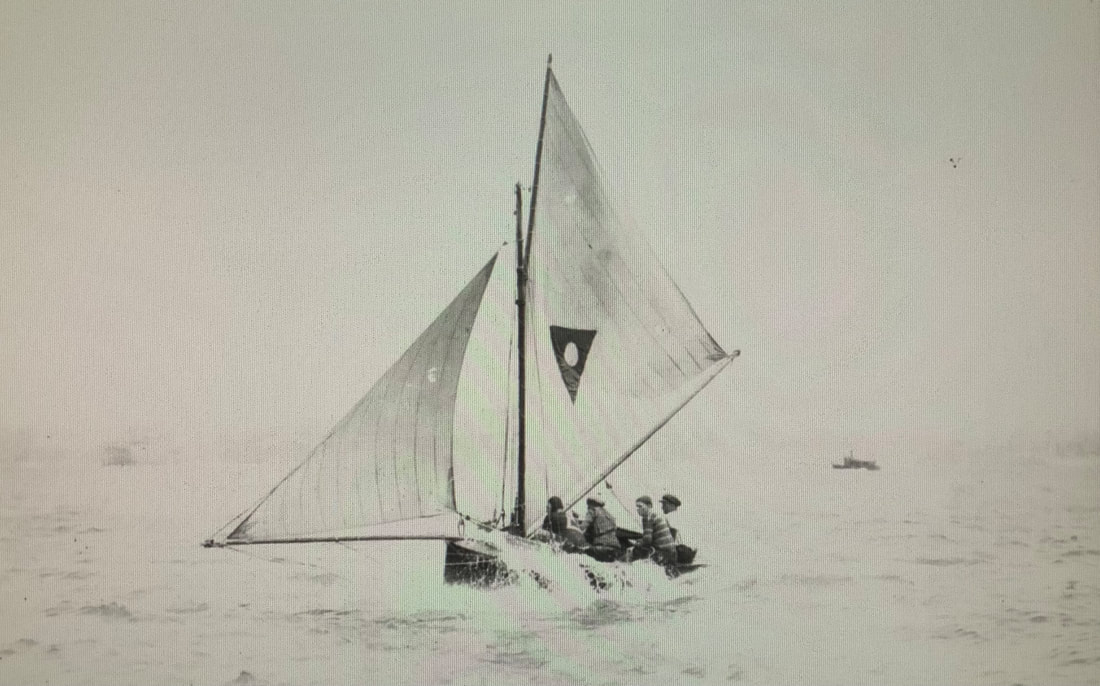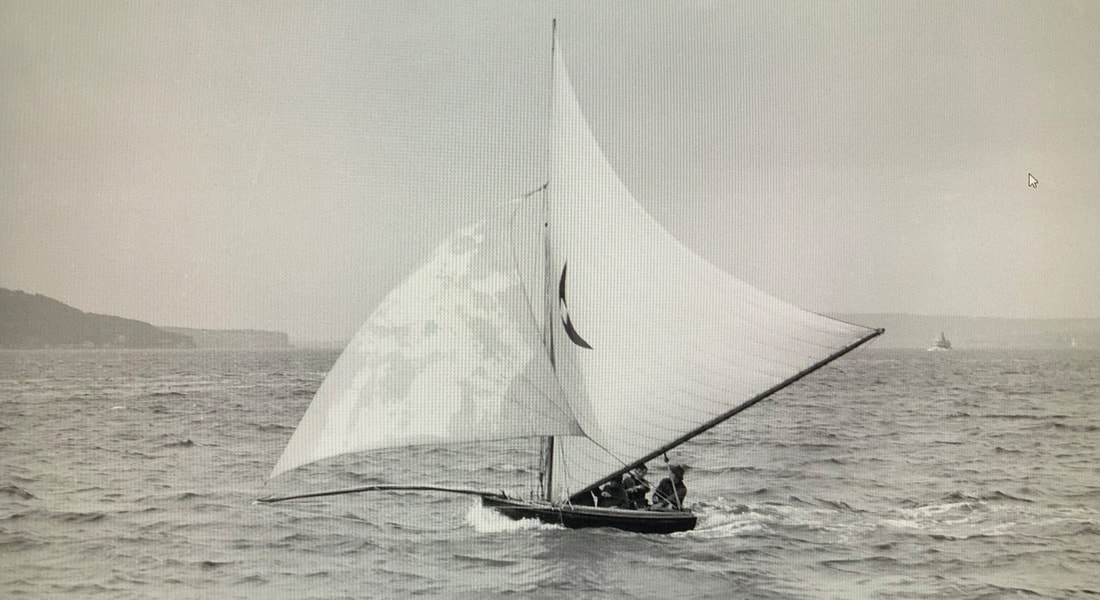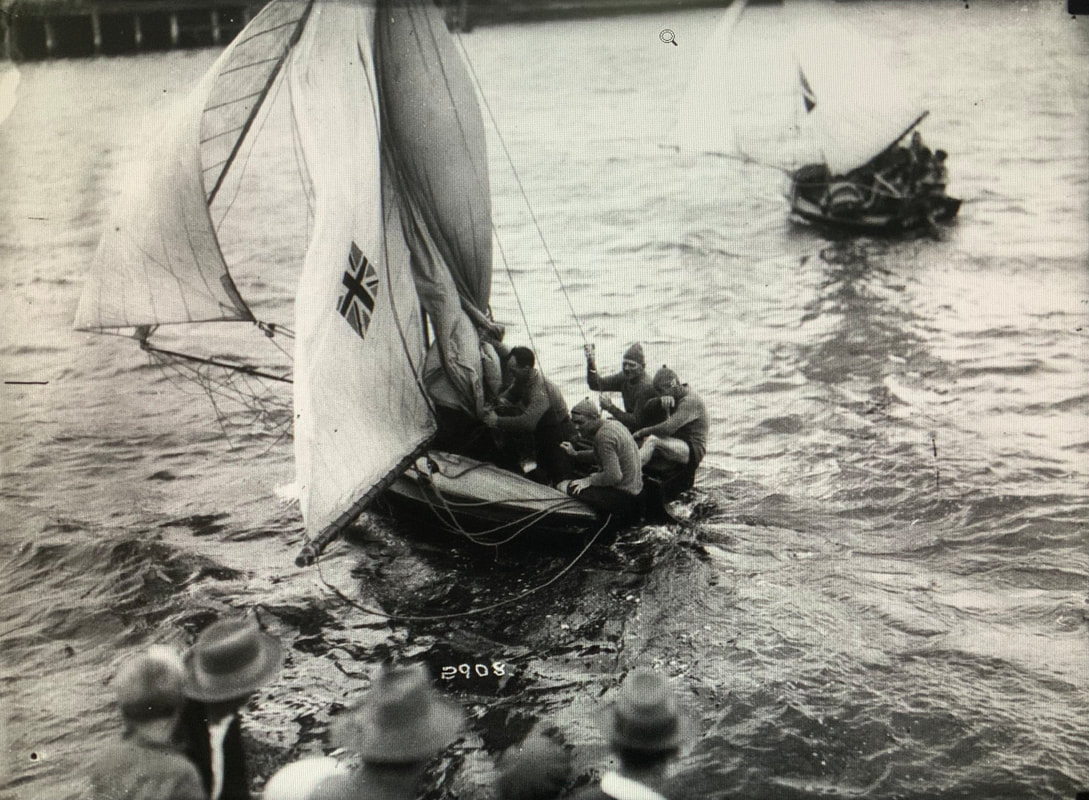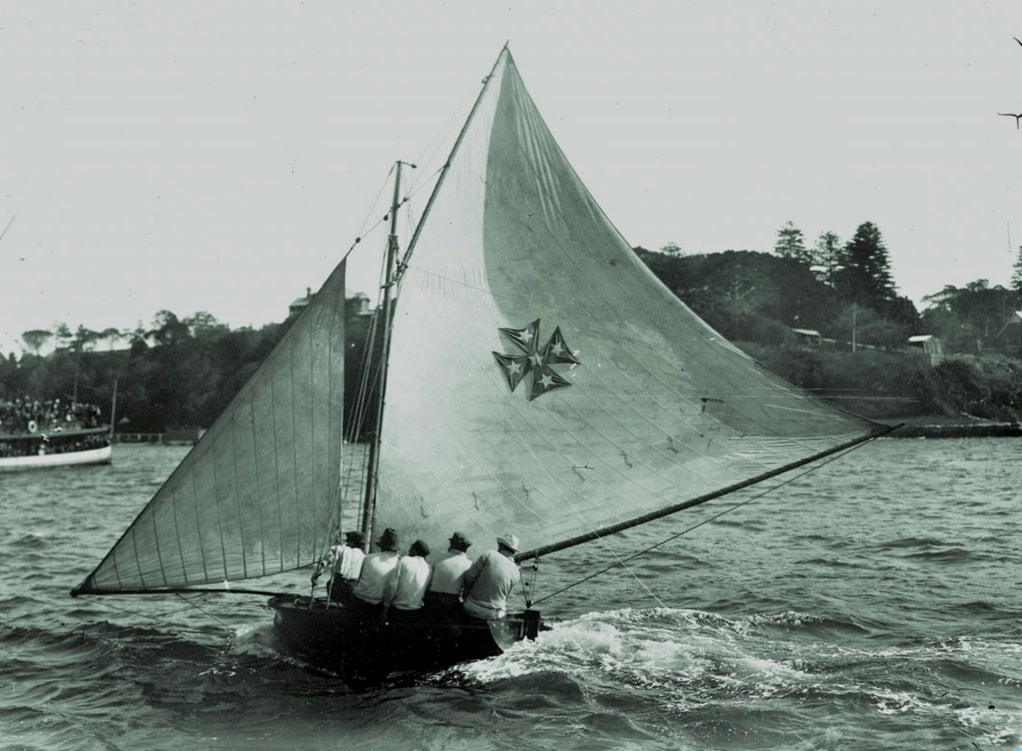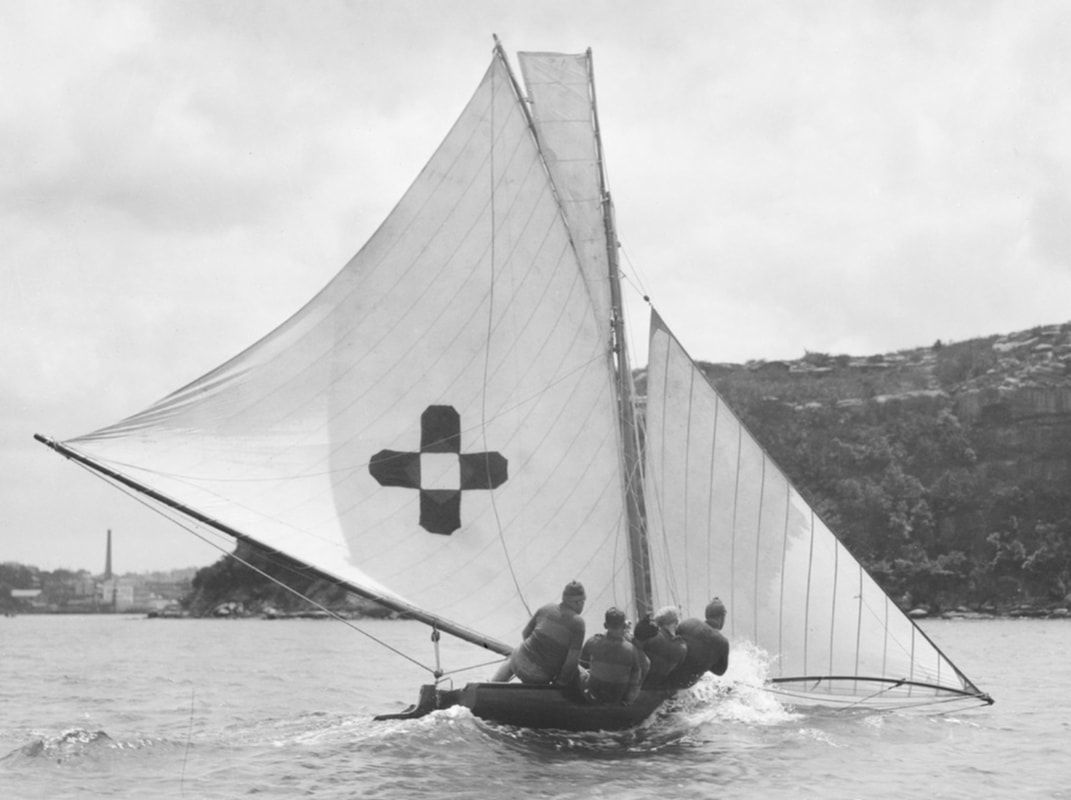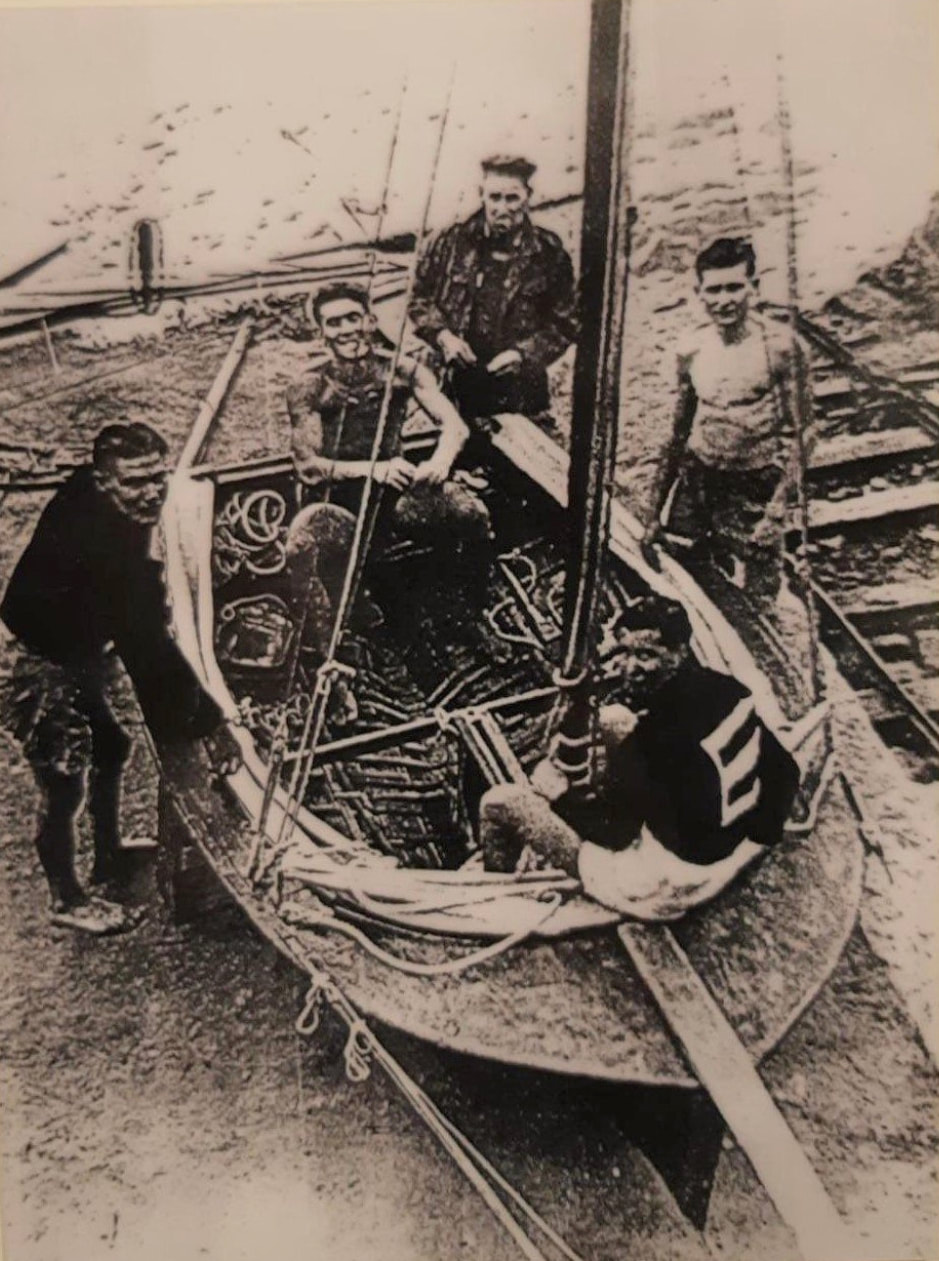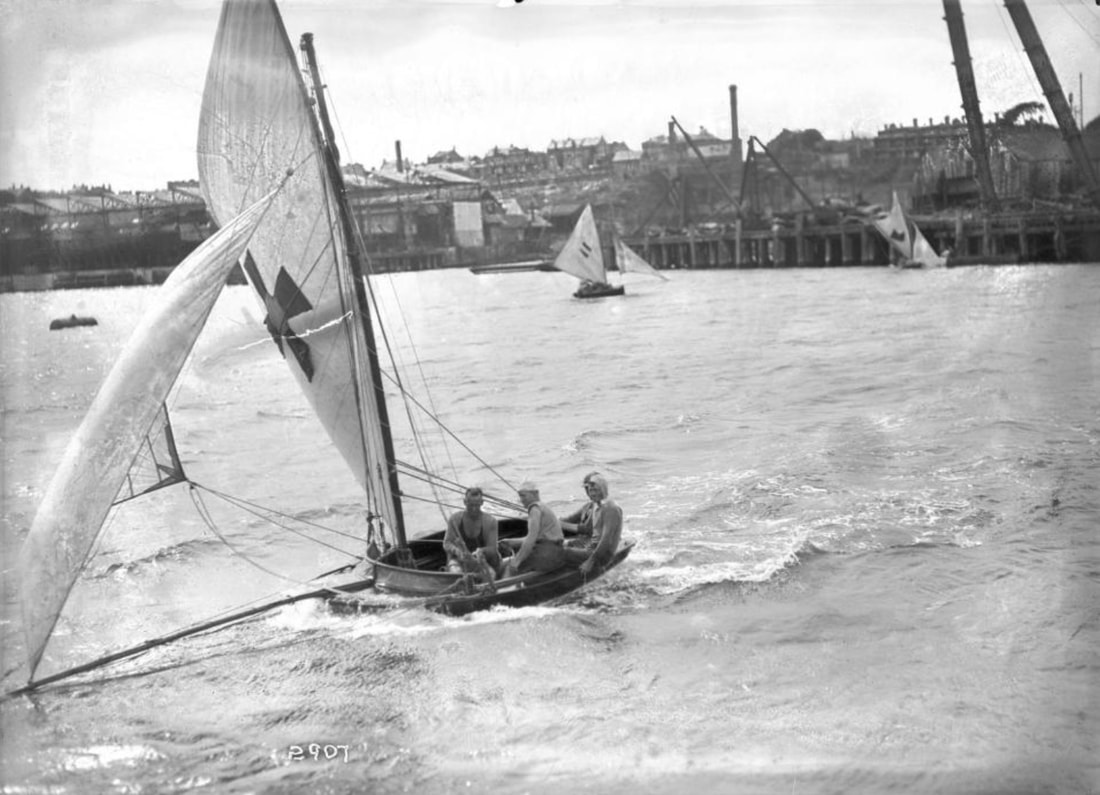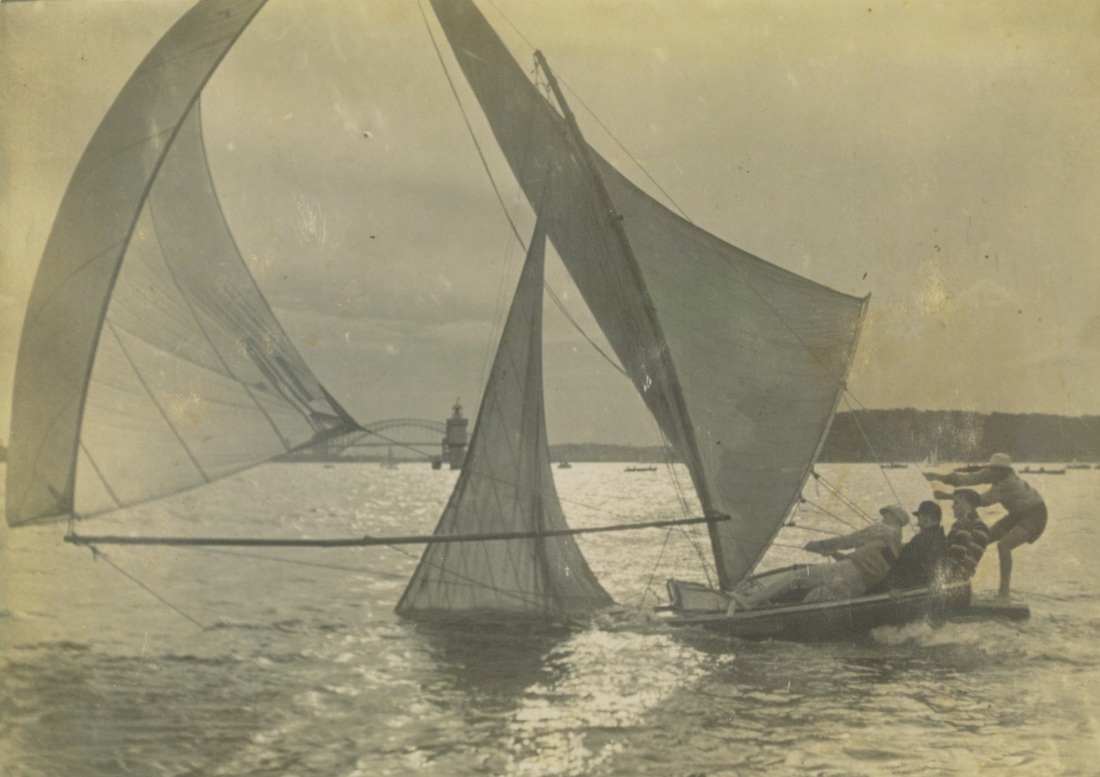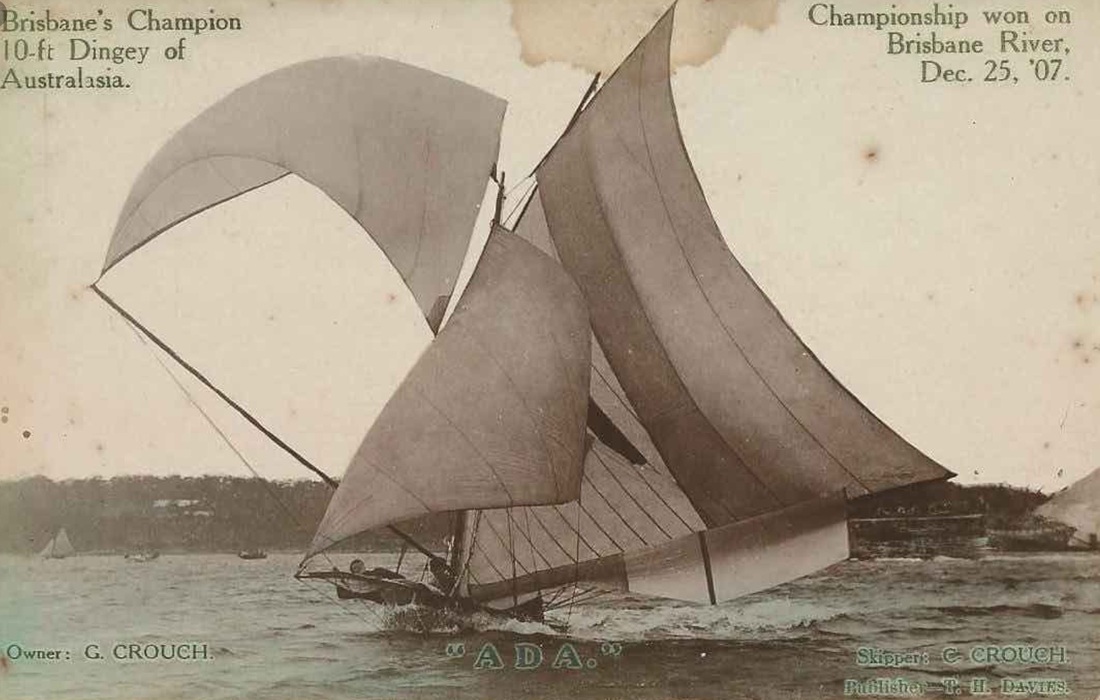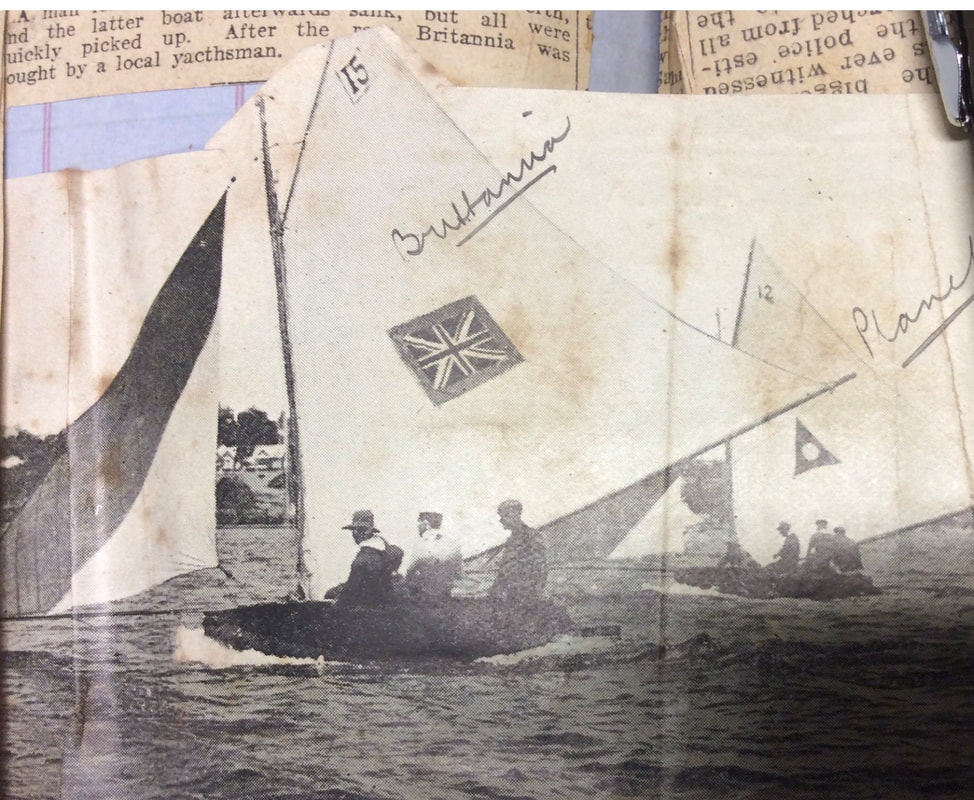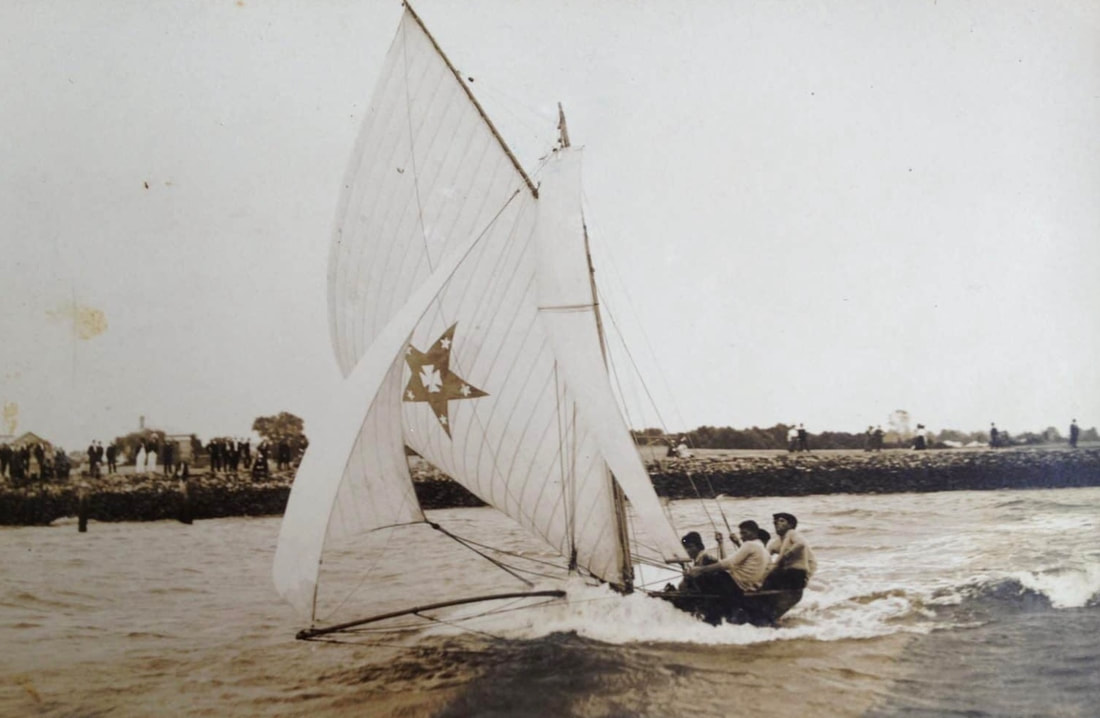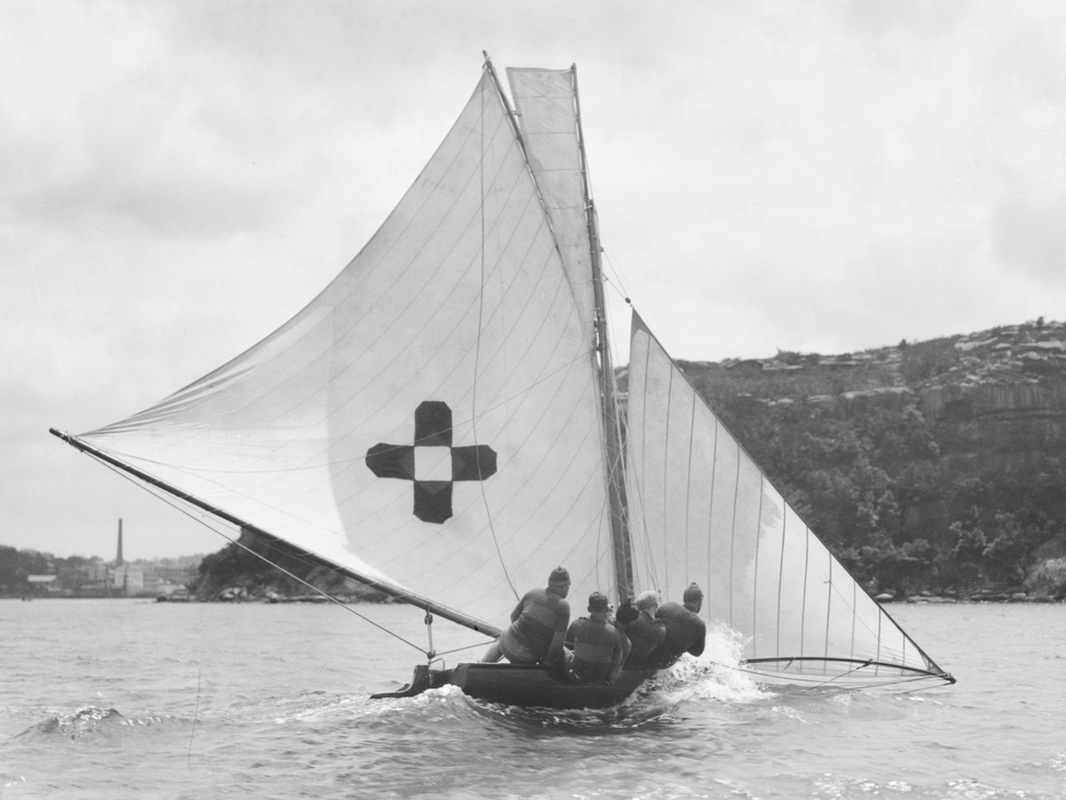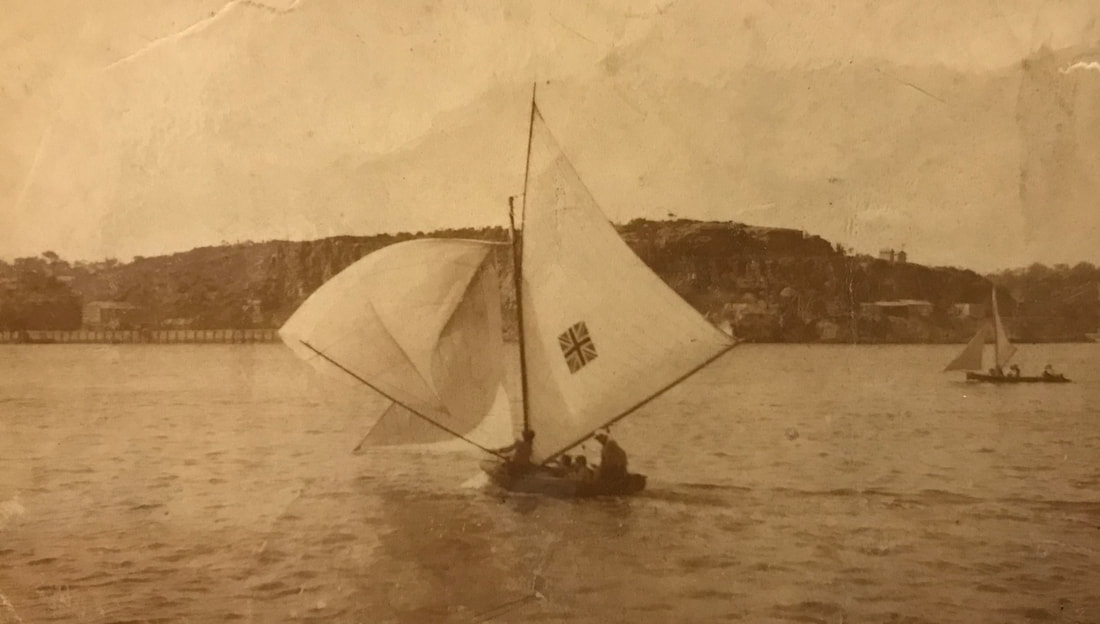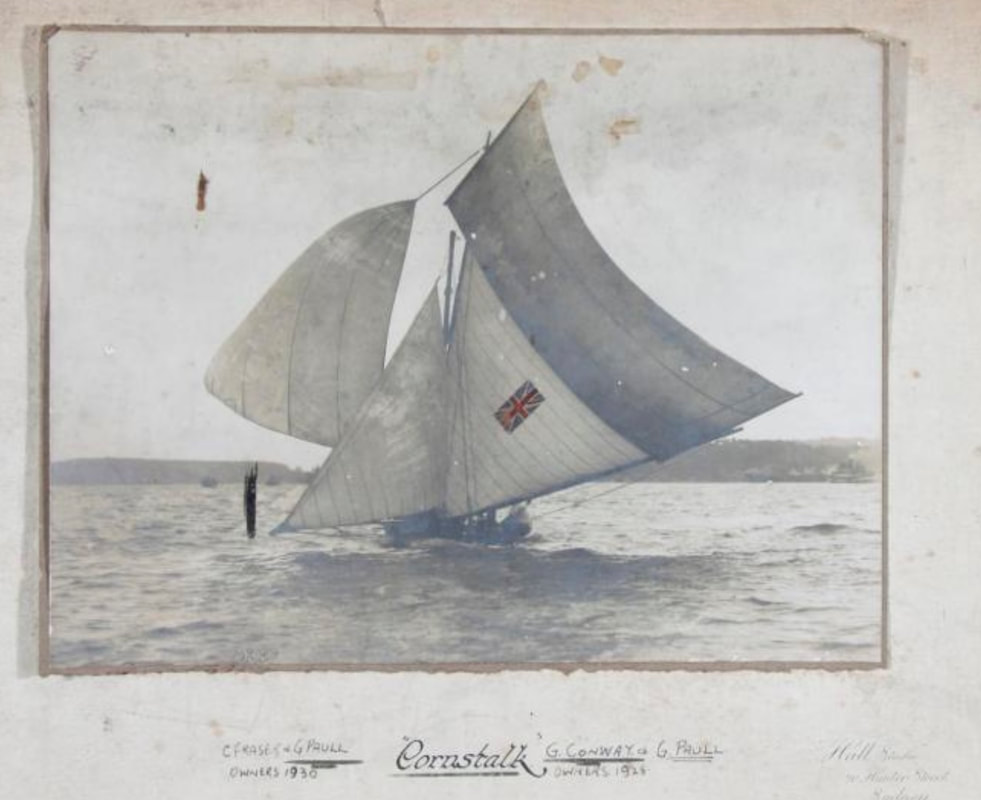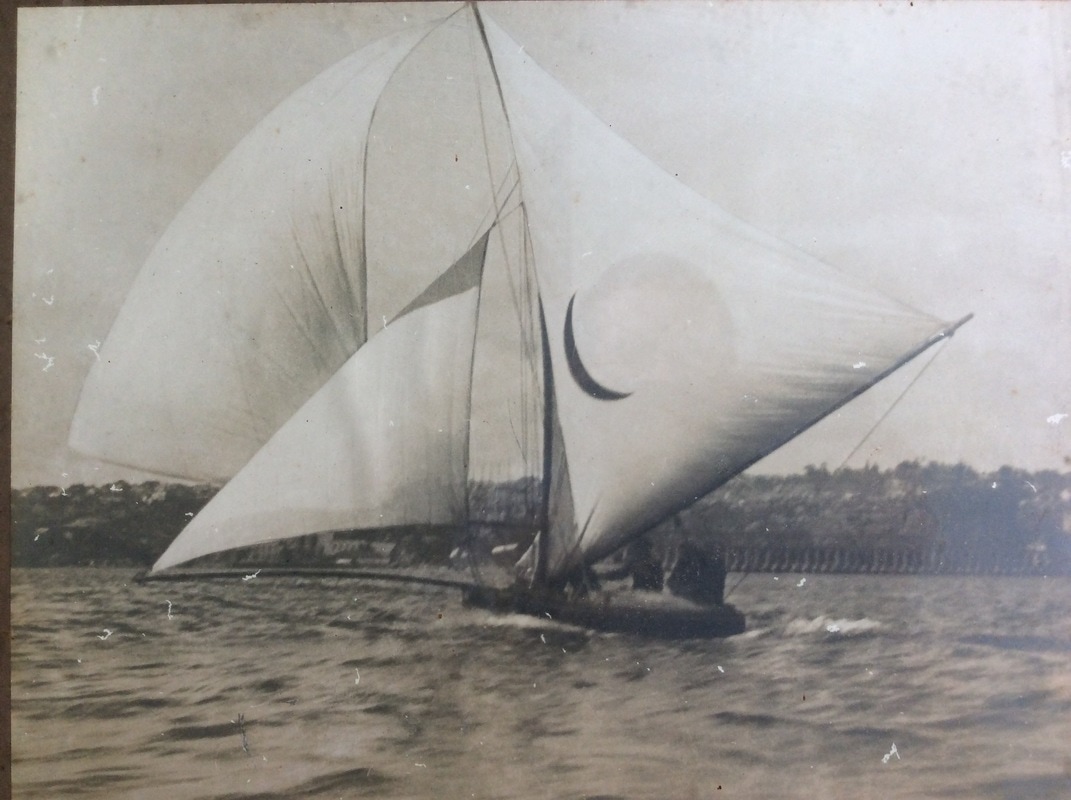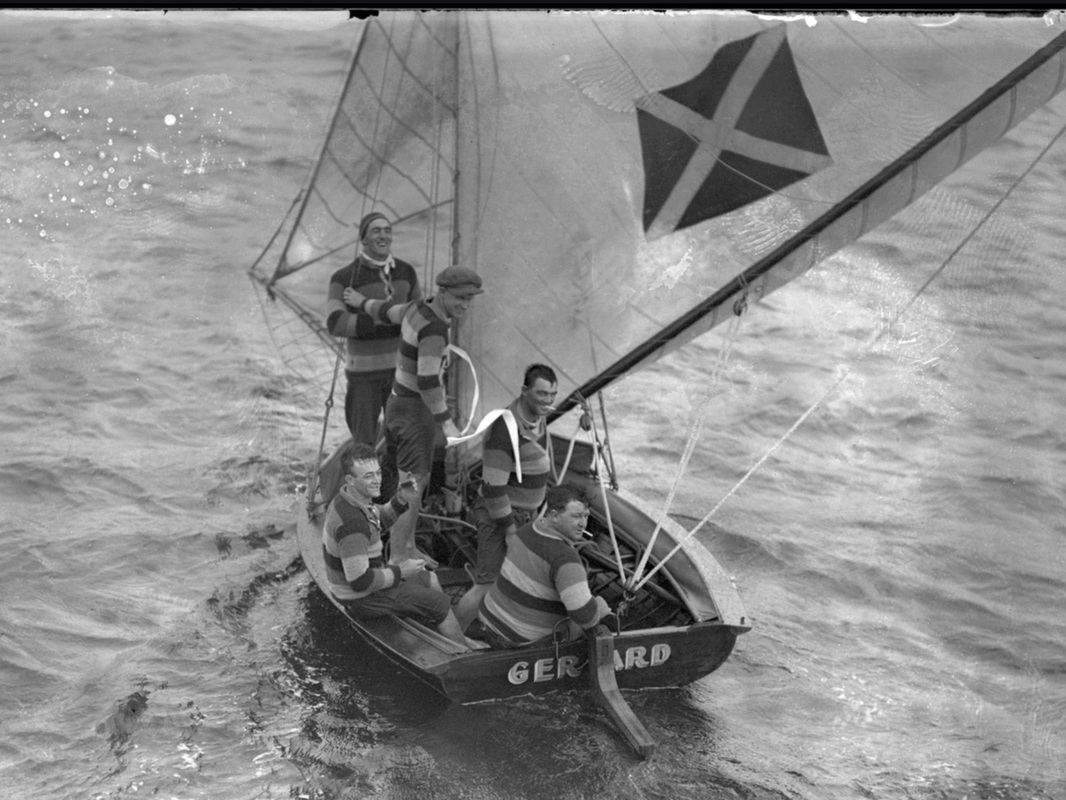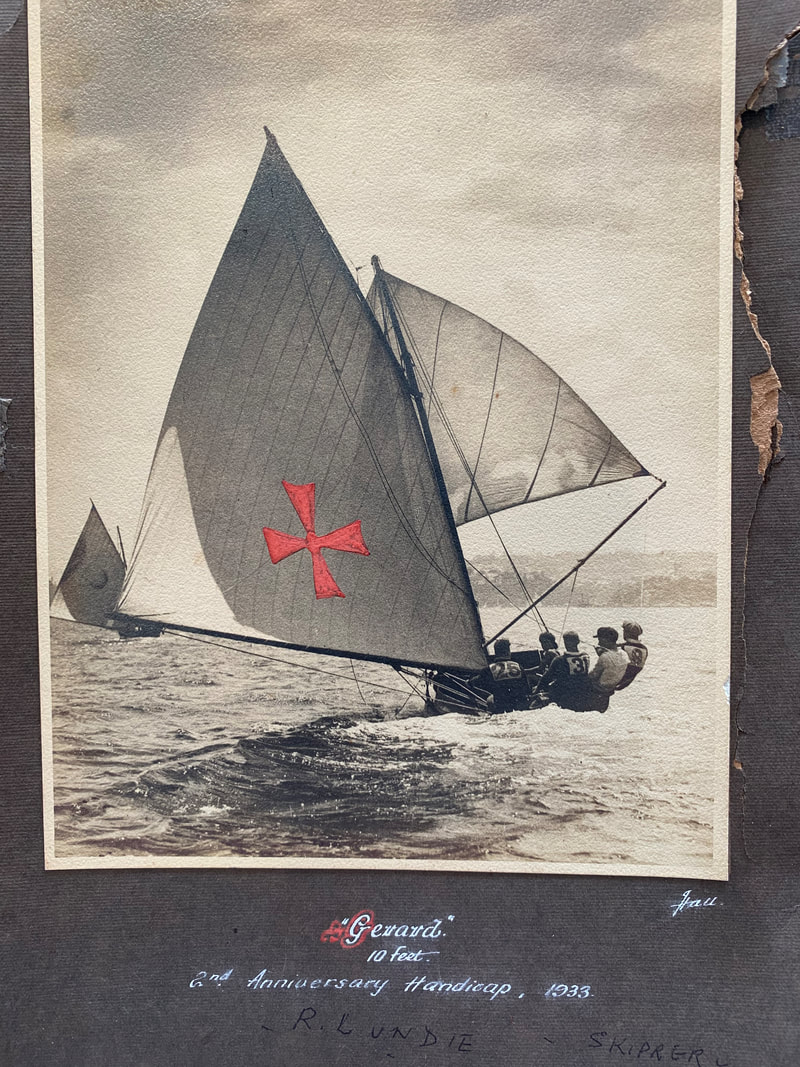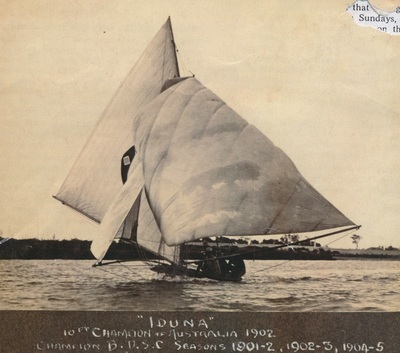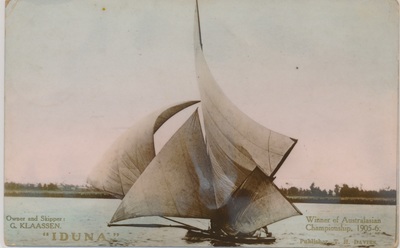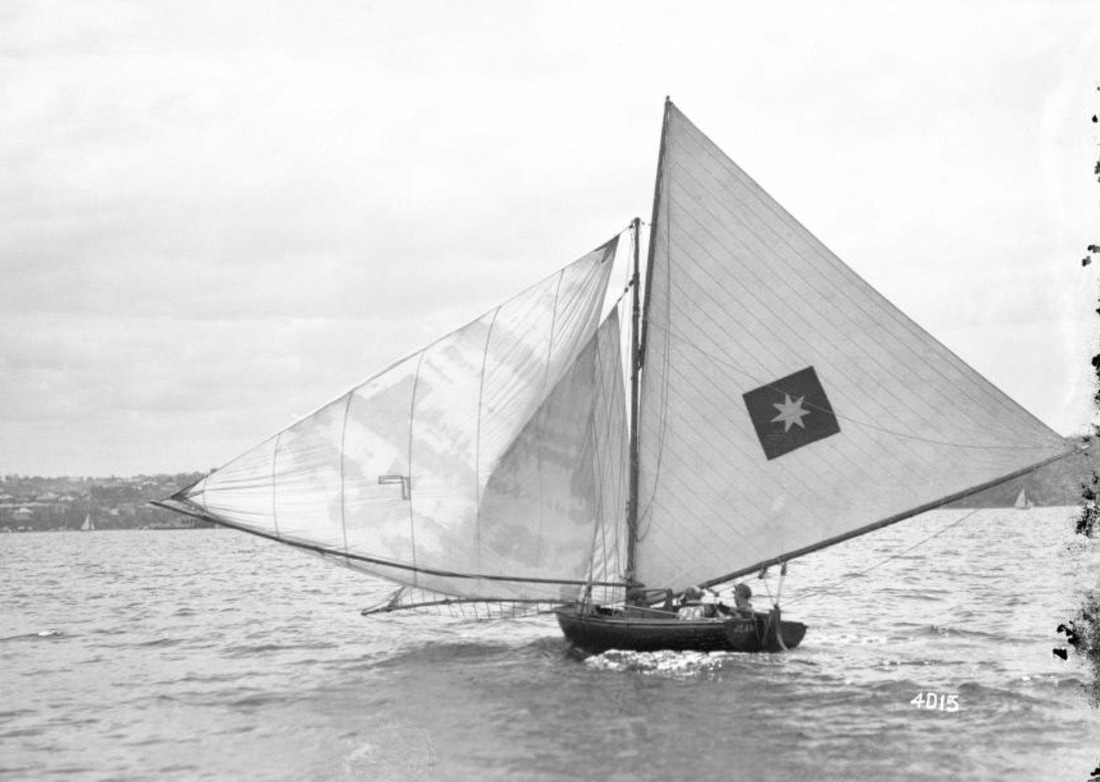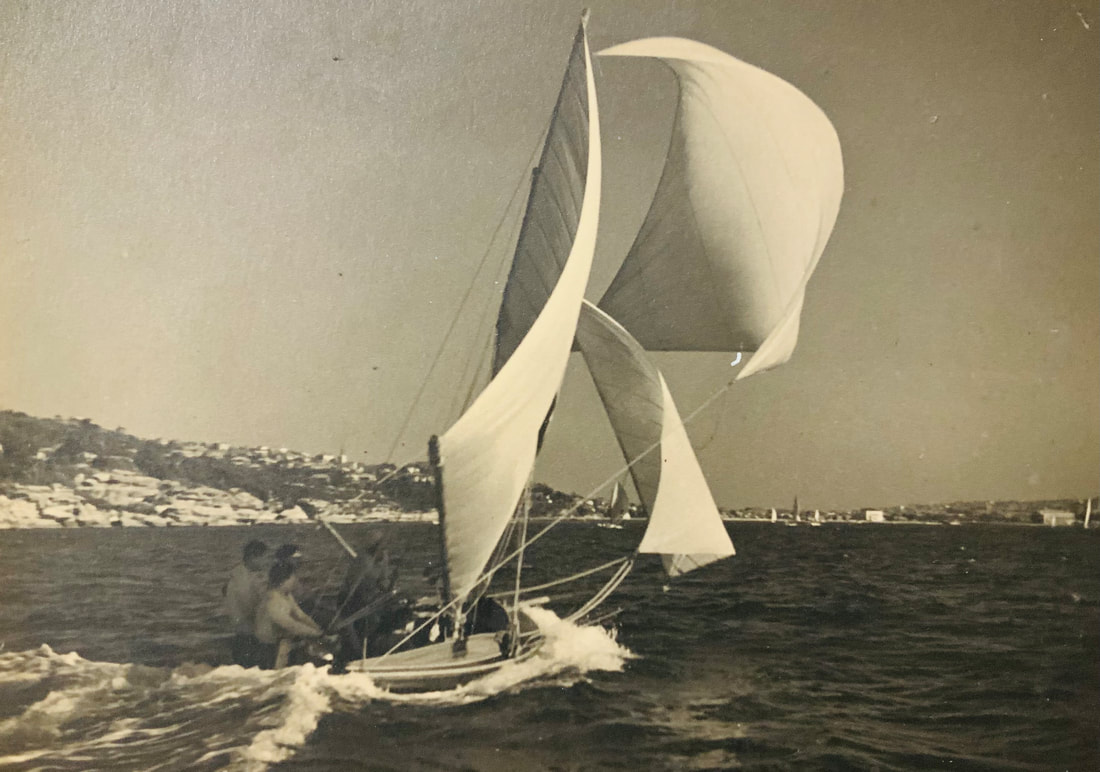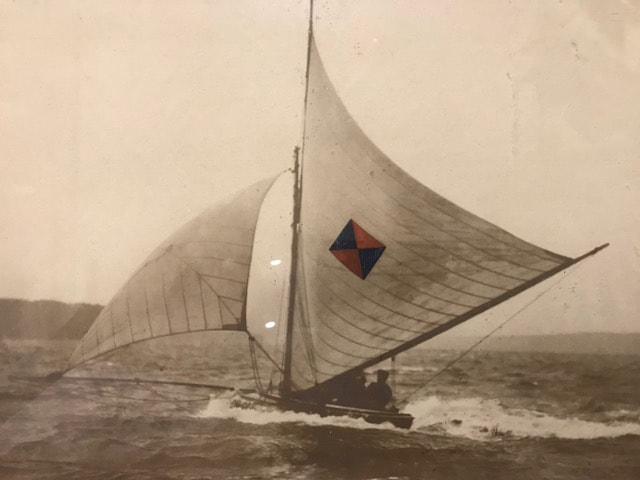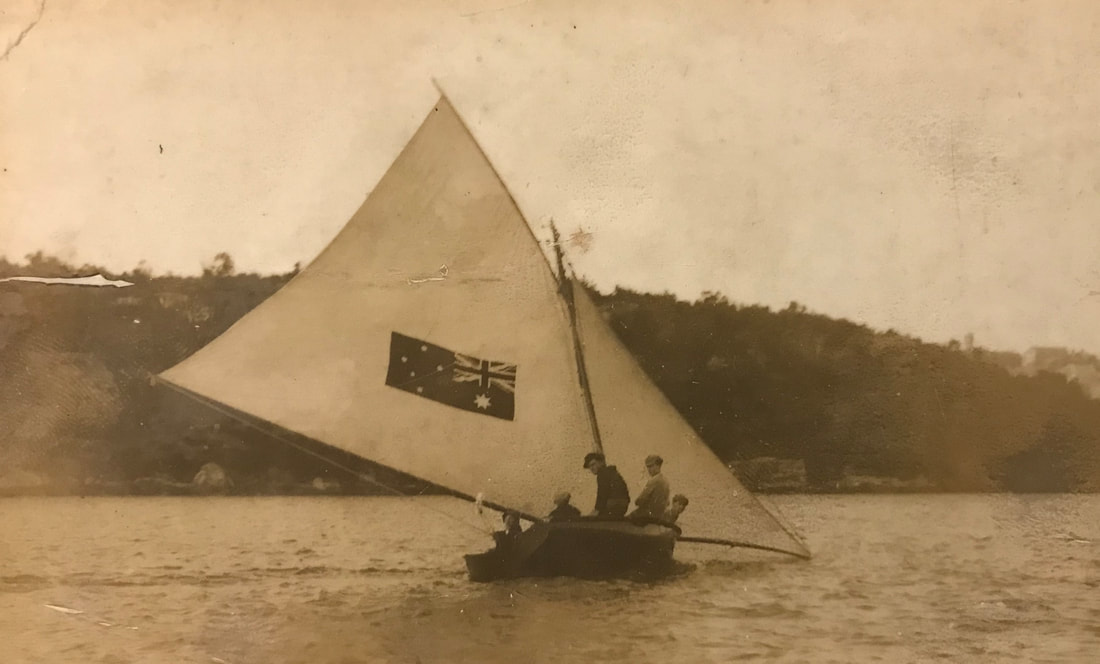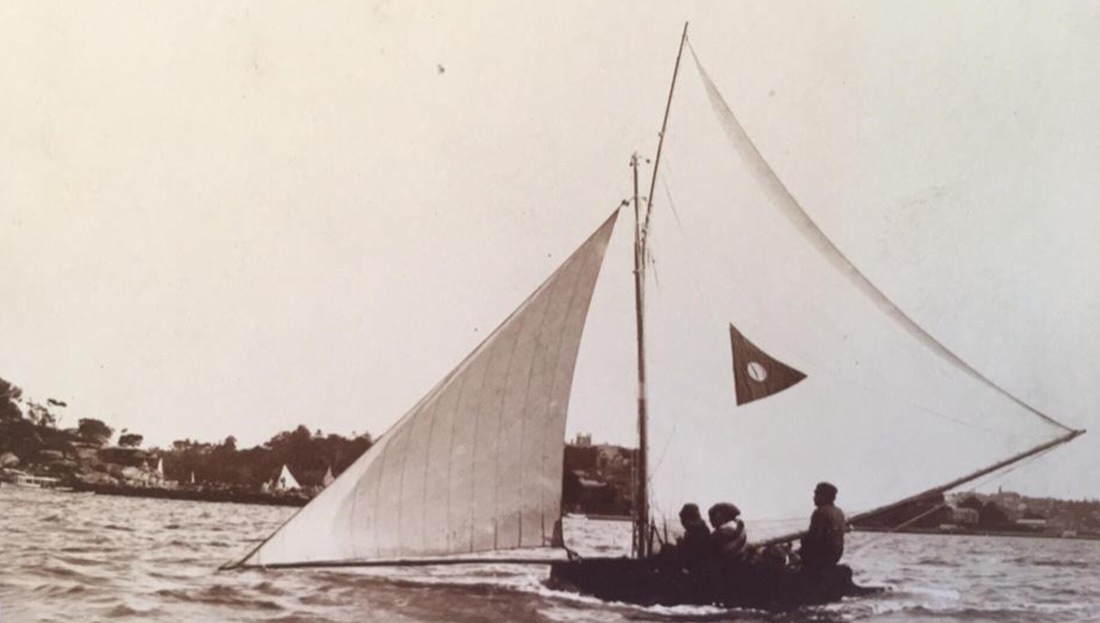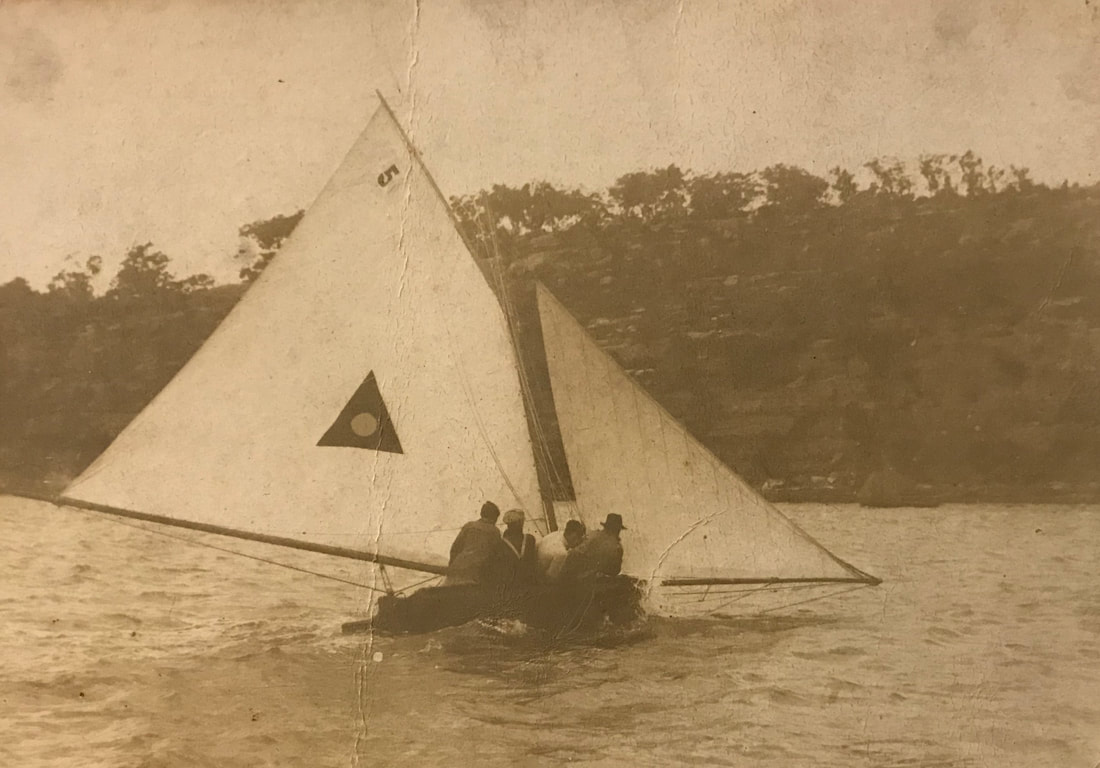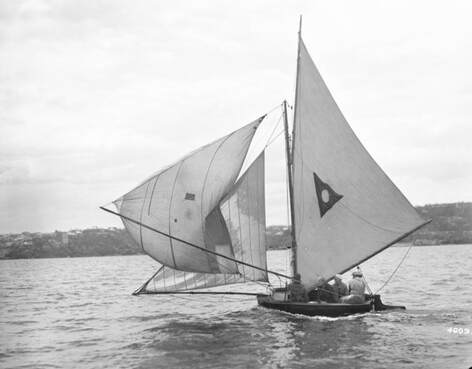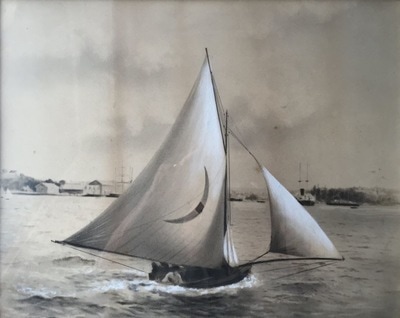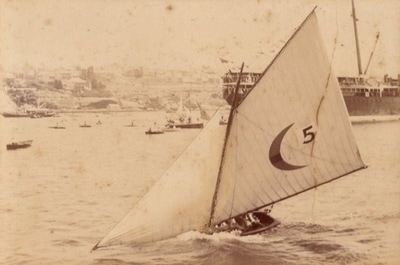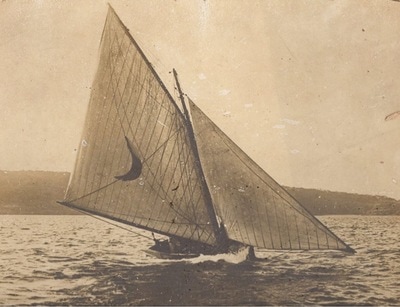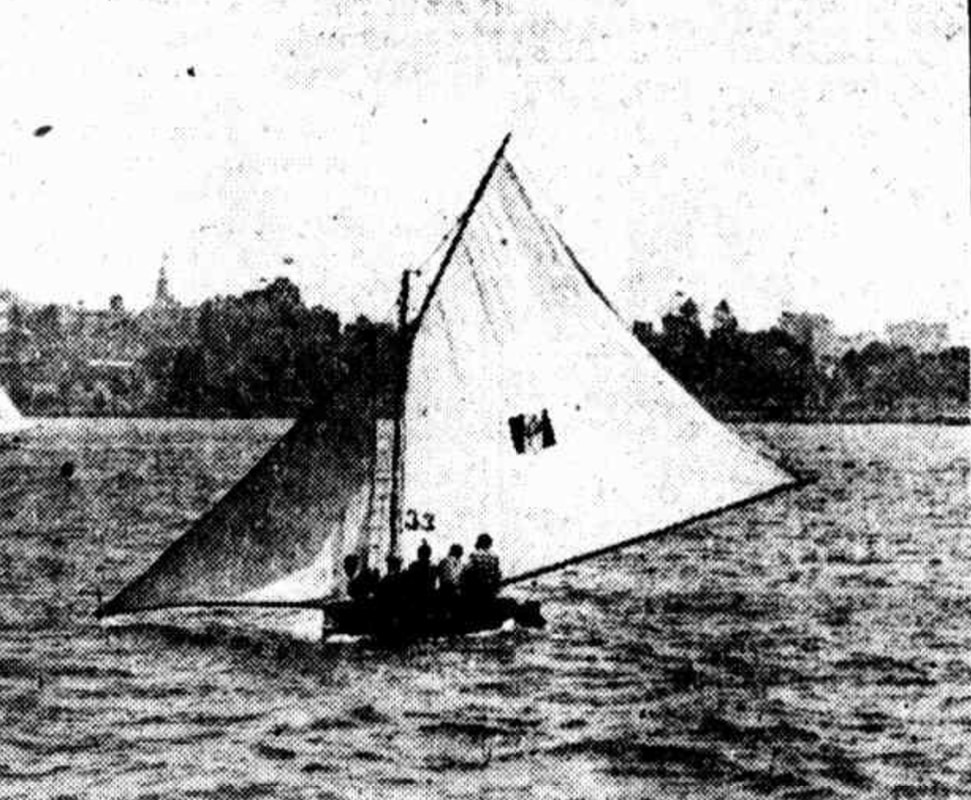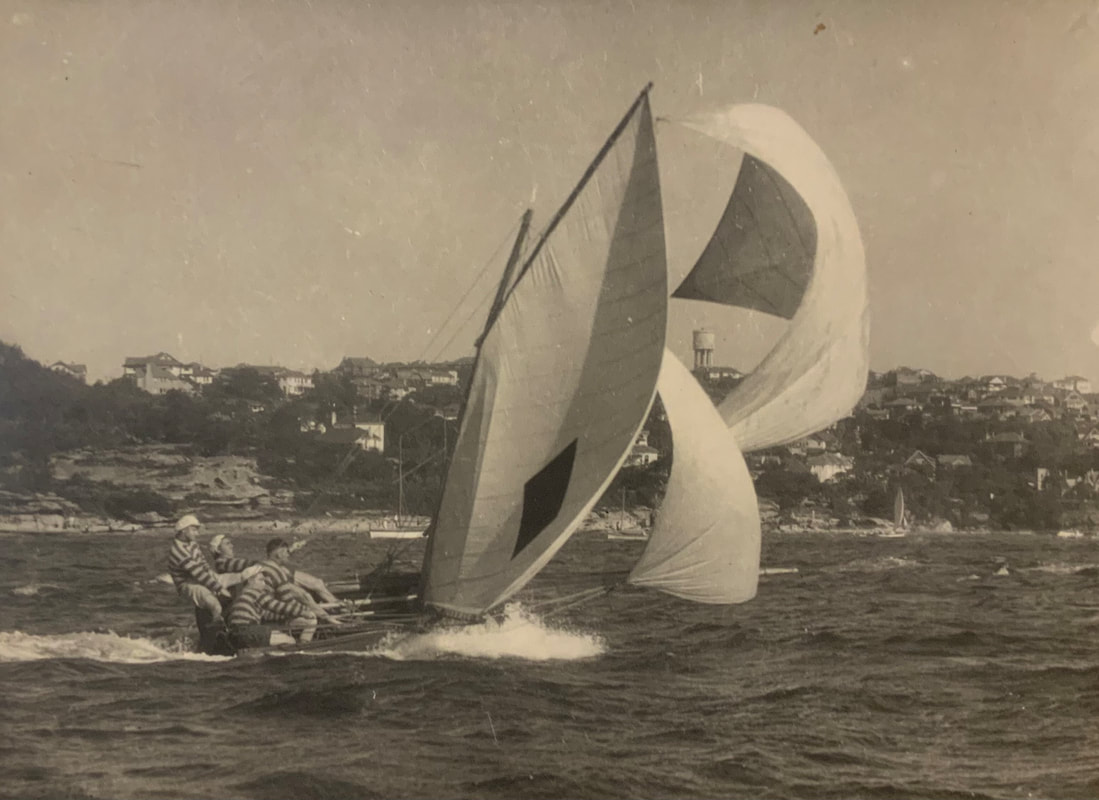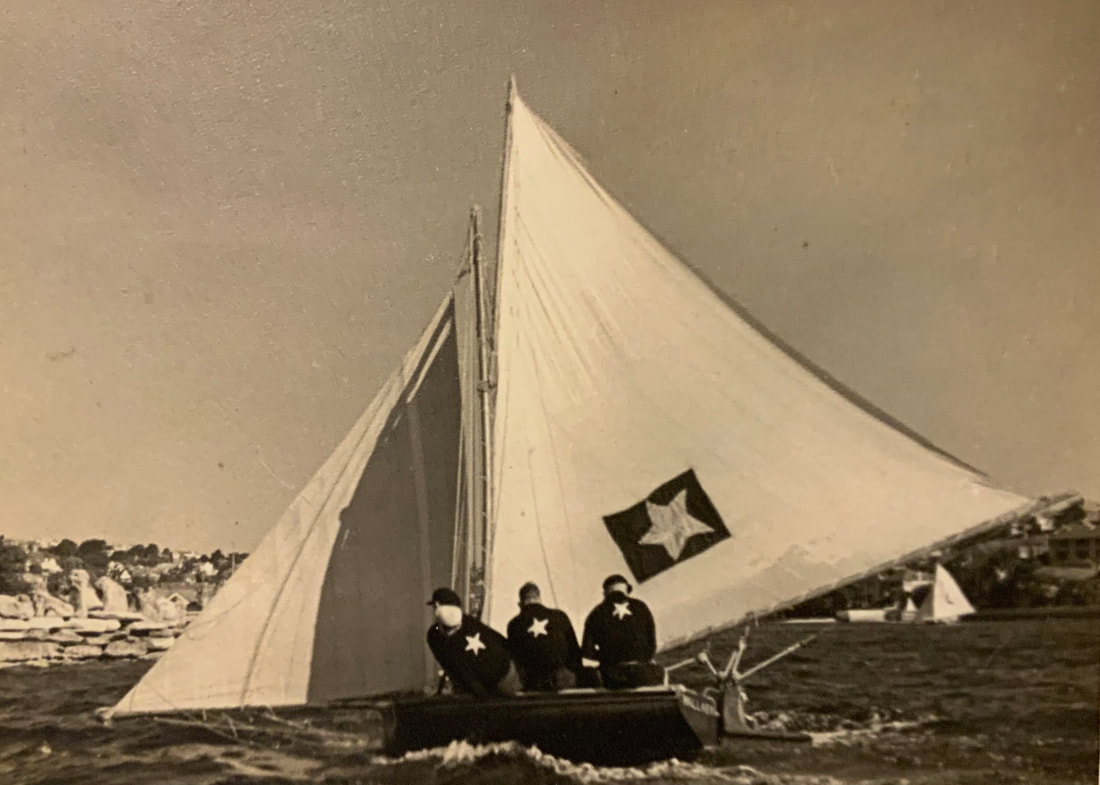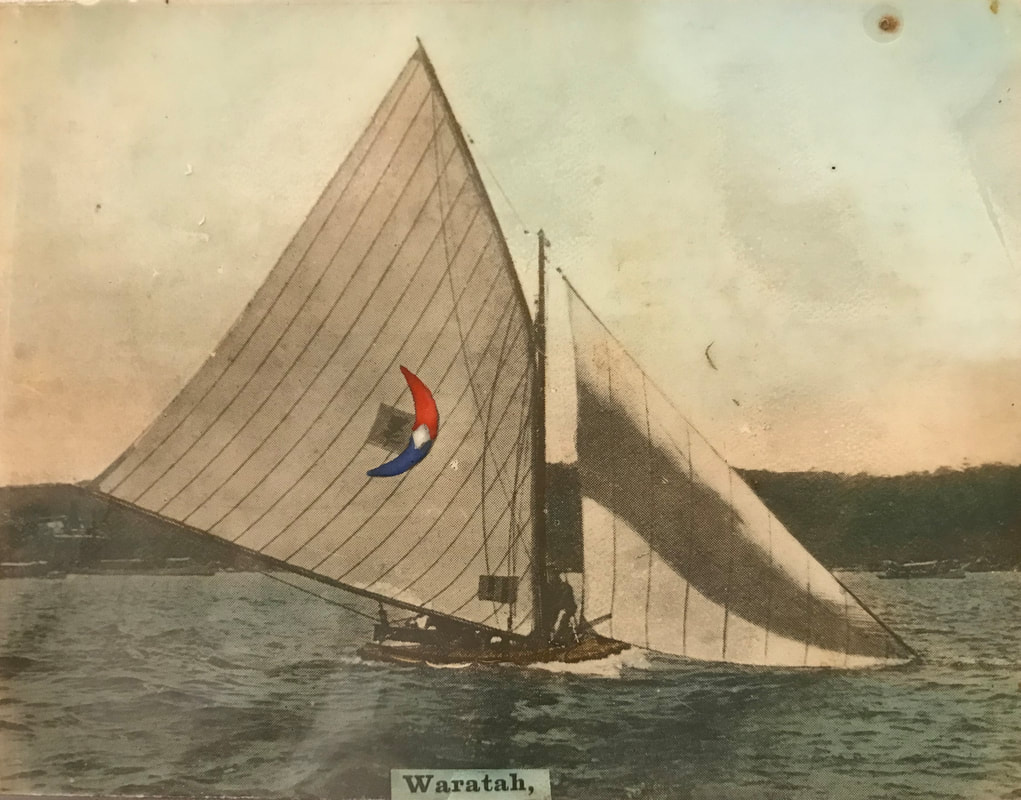Another shot of Planet joins others in her alphabetical listing below. Planet raced from 1895 until at least 1930.
10-footer Waratah on a very empty Harbour. Hall Collection ANMM. Waratah raced from 1907 to 1922 with a break during the War, winning the Australian Championship in 1912. More details below under her alphabetical listing.
The Hall Collection at the ANMM has this classic shot of the crew of the 10-footer Cornstalk stowing their spinnaker with the spectator ferry in close attendance. Cornstalk was built in 1911 and raced at least up until the 1929-30 season when Chook Fraser steered her to victory in the NSW Championship, which the boat had also won in 1922. More on Cornstalk below under her alphabetical listing.
I previously posted this image of a 10-footer from the Hall Collection ANMM, asking would anybody be able to help work out the name on the tuck. AHSSA member Bob Chapman has come up with the most likely possibility…the 10-footer AUSTRALIA.
As I pointed out in the first post, there appears to be the letters ST close to the rudder to Port. Names were commonly split to both sides of the rudder. Australia was originally a Newcastle boat and first appears in the records I’ve found in October 1899. It may have been built by local boatbuilder George Towns as he is listed as skippering in several races with the Port Hunter Sailing Club. A couple of photos of the Newcastle 10-footer fleet in THE NEWCASTLE 10-FOOTERS on the YARNS Page do show a boat with a Maltese cross logo which may have stars on it. Australia visited Sydney a number of times to compete in Championship events, and by about 1907 the boat appears to have been sold to Sydney, racing with the Sydney Dingy Club, the Balmain Dingy Club and the Lane Cove Amateur Sailing Club under W. Durning, and by 1910 under P. Giles. 10-footer racing ceased during the first World War and when it resumed in the late 1920’s Australia does not appear to be involved. Bob Chapman also pointed out that the background is more likely to be Goat Island than Greenwich which I had suggested.
As I pointed out in the first post, there appears to be the letters ST close to the rudder to Port. Names were commonly split to both sides of the rudder. Australia was originally a Newcastle boat and first appears in the records I’ve found in October 1899. It may have been built by local boatbuilder George Towns as he is listed as skippering in several races with the Port Hunter Sailing Club. A couple of photos of the Newcastle 10-footer fleet in THE NEWCASTLE 10-FOOTERS on the YARNS Page do show a boat with a Maltese cross logo which may have stars on it. Australia visited Sydney a number of times to compete in Championship events, and by about 1907 the boat appears to have been sold to Sydney, racing with the Sydney Dingy Club, the Balmain Dingy Club and the Lane Cove Amateur Sailing Club under W. Durning, and by 1910 under P. Giles. 10-footer racing ceased during the first World War and when it resumed in the late 1920’s Australia does not appear to be involved. Bob Chapman also pointed out that the background is more likely to be Goat Island than Greenwich which I had suggested.
Commonwealth built in 1906 by Norm Wright Snr in Brisbane, pictured here in Sydney in the 1920's was one of the first 10-footers replicated by Robert Tearne and the Australian Historical Sailing Skiff Association. The Historical 10-Footers soon evolved into a class of their own and provide exciting racing. This Page tells the story of the original boats including an alphabetical listing of many of them. The replica has not sailed for quite a few seasons but has been restored and will race in the 30th AHSSA Historical 10-Footers Championships at Teralba on Lake Macquarie 4-6 May 2024 and photos and results will be posted on our companion site www.historicskiffs.org.au Photo from Hall Collection, ANMM.
Australian Historical Sailing Skiff Association Patron Phil Boyd has this image of his father Jack’s 10-footer Merle at Dan Boyd’s boatshed, Louisa Rd Birchgrove, 1934-35. The boat was built as Truant in 1914. Lou Colligan (sheethand) seated at stern. Walter “Kookum” Nash, frd hand outside port stern wearing cap (30 years older than the rest). Allan Lonnon (swinger) port side no shirt. Allan supplied this photo to Jack. Stan McCue (swinger) seated at bow, two blue bars on jersey. Jack Boyd (skipper) in black at left, aged 17, won his first 10’s race at 15. Both Jack and Allan were early members of the AHSSA and were both very helpful with their knowledge of 10-footers when the first replicas were built. Great detail of the interior of a 10-footer.
At first this boat was unidentified, but I'm pretty sure it is Gerard* sailed by Horrie Balkwell , photo from the Hall Collection. I was not sure of the location, thought it could be Cockatoo island with Balmain in the background, but on posting the image to Facebook, a hawk-eyed Friend identified it as looking into Mort Bay. The sheerlegs on the right are on the Ballast Point side, the big sawtooth roof shed is part of Mort's Dock.
A great shot of Blue Peter, a ten-footer owned and steered by Laurie Blake for several seasons in the mid- to late-1930's. The boat was generally a long marker in the handicaps, and they seem to have their work cut out for them here. They may or may not have survived this nose dive. If the bow had popped out, the man standing on the rudder would have had to leap back into the boat or they would have capsized by the stern. How do I know? We've done it on the replica tens!
The ten footers first appeared at the Balmain Regatta in 1887, when they were canvas boats, that is, canvas stretched over a wooden framework and painted for waterproofing, and the crews were restricted to youths. The age limit disappeared in the late 1890's, and all-wooden boats began to appear by then. By the turn of the century the competitive boats were all of batten-seam carvel construction like all the other classes discussed here. They became established in the mid 1890's in Brisbane and the early 1900's in Newcastle and Perth, and the first National Championship was held as far as I can tell in 1905-06 but interstate competition between Queensland and NSW had been happening annually since the mid-1890's. They stopped racing with the outbreak of the First World War, and though numbers fluctuated they resumed in the early 1920's and continued through the 1920's and 1930's and into the 1940's. I haven't yet determined the last race, but it appears to have been in the 1940-41 season.
The ten-footers had a crew of four or five and carried every sail the bigger boats carried, including tops'l, balloon jibs, spinnakers, ringtails and watersails. They were difficult to sail and were considered a great training ground for the larger classes.
The Australian Historical Sailing Skiff Association built and raced a number of ten footer replicas from the early 1990's and the fleet still races in Sydney, Lake Macquarie and Brisbane.
The ten footers first appeared at the Balmain Regatta in 1887, when they were canvas boats, that is, canvas stretched over a wooden framework and painted for waterproofing, and the crews were restricted to youths. The age limit disappeared in the late 1890's, and all-wooden boats began to appear by then. By the turn of the century the competitive boats were all of batten-seam carvel construction like all the other classes discussed here. They became established in the mid 1890's in Brisbane and the early 1900's in Newcastle and Perth, and the first National Championship was held as far as I can tell in 1905-06 but interstate competition between Queensland and NSW had been happening annually since the mid-1890's. They stopped racing with the outbreak of the First World War, and though numbers fluctuated they resumed in the early 1920's and continued through the 1920's and 1930's and into the 1940's. I haven't yet determined the last race, but it appears to have been in the 1940-41 season.
The ten-footers had a crew of four or five and carried every sail the bigger boats carried, including tops'l, balloon jibs, spinnakers, ringtails and watersails. They were difficult to sail and were considered a great training ground for the larger classes.
The Australian Historical Sailing Skiff Association built and raced a number of ten footer replicas from the early 1990's and the fleet still races in Sydney, Lake Macquarie and Brisbane.
Ada 1905?
Ada is first seen in coming second to Iduna (see below) in the December 1905 Interstate 10 footer Championship. She was owned and sailed by G.Crouch who won the Interstates again in 1907 and in 1909. She was occasionally steered by Norman Wright. Crouch raced Ada until 1914, after which the ten footers folded in Brisbane.
Britannia 1899
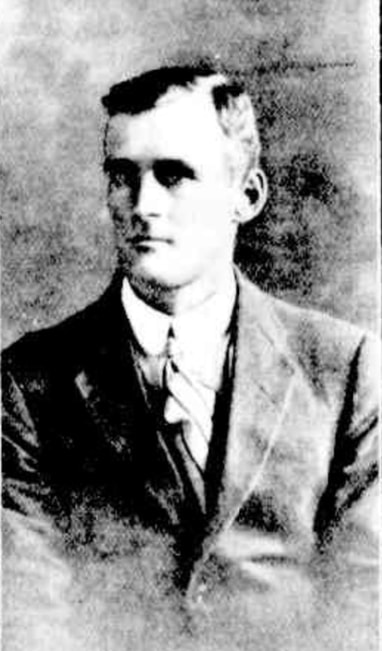
Builder: Unknown
Insignia: Union Jack with wide border.
Britannia (no connection to Wee Georgie Robinson*) is first found in a Johnstones Bay Sailing Club race (Sydney) in November 1899 steered (unsuccessfully) by Alf Holmes. She is next found racing in 1900 with the Port Hunter Sailing Club in Newcastle NSW 100 miles North of Sydney, and sailed there for several seasons under Wally Arnott of the biscuit-making family (see NEWCASTLE 10-FOOTERS on the YARNS Page). She was unplaced in an interstate race in Brisbane in 1903, and at some stage appears to have been sold to a Sydney owner as she appears in race reports in Sydney in 1907 and 1908. By 1909 she was owned by J B Moffatt, a solicitor who took her to Brisbane for the Interstate Championship and steered himself but was unplaced. By 1911 he still occasionally steered himself but often engaged T Kell to steer. Moffatt took the boat to Perth for the Interstate Championship in January 1911 and Britannia won steered by Kell. Moffatt sold the boat in Perth, and the new owner represented Western Australia in the Australian Championship in Sydney in 1912 (where the photo above appears to have been taken, from the Golding Scrapbook, ANMM). After the Championship in Sydney she returned to Perth and sailed with the Perth Dinghy Club until 1922. The photo below is in a frame marked "Britannia 1918" which is clearly taken in Sydney, so it is possible that she travelled to Sydney in that year, but I can't find a report of any Interstate Championship racing during the war years, so the photo inscription might be wrong. She took part unsuccessfully in the Australian Championship in Perth in 1922, immediately after which she was one of 7 ten-footers that were destroyed in the boatshed fire that also claimed the WA 18-footer Mele Bilo (I).
Above: JB Moffatt, Britannia's owner from 1909
or before until 1911. He was Commodore of the
Sydney Dinghy Club and Vice-Commodore of
both the Lane Cove Amateur Sailing Club and the Balmain Dinghy Club, all of which held races for 10-footers. Photo from TROVE, supplied along with some of the information in this section by his Great Grandson Nick Moffatt.
Insignia: Union Jack with wide border.
Britannia (no connection to Wee Georgie Robinson*) is first found in a Johnstones Bay Sailing Club race (Sydney) in November 1899 steered (unsuccessfully) by Alf Holmes. She is next found racing in 1900 with the Port Hunter Sailing Club in Newcastle NSW 100 miles North of Sydney, and sailed there for several seasons under Wally Arnott of the biscuit-making family (see NEWCASTLE 10-FOOTERS on the YARNS Page). She was unplaced in an interstate race in Brisbane in 1903, and at some stage appears to have been sold to a Sydney owner as she appears in race reports in Sydney in 1907 and 1908. By 1909 she was owned by J B Moffatt, a solicitor who took her to Brisbane for the Interstate Championship and steered himself but was unplaced. By 1911 he still occasionally steered himself but often engaged T Kell to steer. Moffatt took the boat to Perth for the Interstate Championship in January 1911 and Britannia won steered by Kell. Moffatt sold the boat in Perth, and the new owner represented Western Australia in the Australian Championship in Sydney in 1912 (where the photo above appears to have been taken, from the Golding Scrapbook, ANMM). After the Championship in Sydney she returned to Perth and sailed with the Perth Dinghy Club until 1922. The photo below is in a frame marked "Britannia 1918" which is clearly taken in Sydney, so it is possible that she travelled to Sydney in that year, but I can't find a report of any Interstate Championship racing during the war years, so the photo inscription might be wrong. She took part unsuccessfully in the Australian Championship in Perth in 1922, immediately after which she was one of 7 ten-footers that were destroyed in the boatshed fire that also claimed the WA 18-footer Mele Bilo (I).
Above: JB Moffatt, Britannia's owner from 1909
or before until 1911. He was Commodore of the
Sydney Dinghy Club and Vice-Commodore of
both the Lane Cove Amateur Sailing Club and the Balmain Dinghy Club, all of which held races for 10-footers. Photo from TROVE, supplied along with some of the information in this section by his Great Grandson Nick Moffatt.
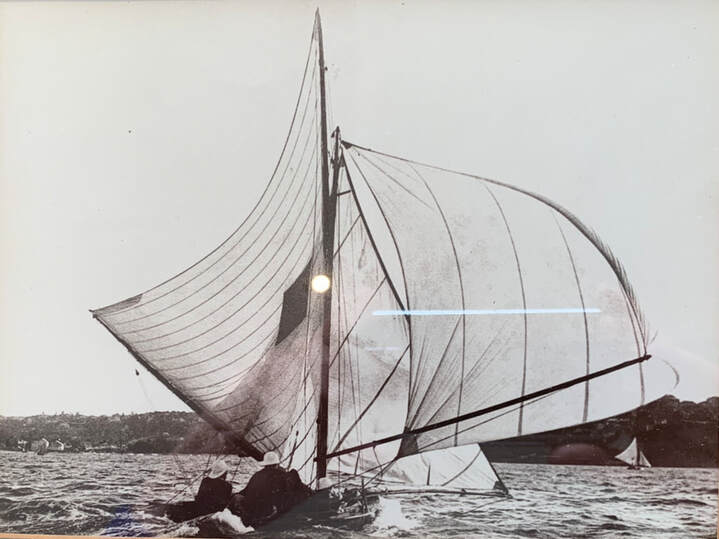
This shot is clearly taken in Sydney, and was found in a frame marked "Britannia 1918" but I can find no record of the boat being in Sydney at that time. From 1911 to 1922 she was in Perth. Photo Sydney Flying Squadron Collection.
Commonwealth 1906
Builder: Norman Wright Senior, Bulimba, Brisbane
Known dimensions:Length 10', beam 6', depth 2'.The original half-model still exists in the care of the Wright family, and a lines plan was drawn off the model by Norm Wright Jnr and a copy is in the archives of the AHSSA and reprinted in The Open Boat book. Robert Tearne and Graeme Ferguson built a replica in the early 1990's which still occasionally sails.
Sails: Main hoist 13'9", gaff 11'10",foot 19'6", leech 24'6", area about 280 sq ft. Jib luff 22", foot 14'10", leech 15'5", about 110 sq ft.
Commonwealth was built in 1906 from a cedar log that floated past the Wright's Bulimba shed in a flood. She was a winner straight away, winning a Championship according to Norm Wright Jnr on the day she was launched, and was Queensland Champion for most of the next few years. She visited Sydney in 1912 for the Australian Championship but was unplaced. She continued to race successfully in Brisbane and was the Australian Champion in 1914, but the Brisbane 10 footers ceased racing in the First World War. Commonwealth was sold to G.Conway in Sydney in 1924. She won the Balmain Regatta that year, won the Australia Day Regatta early in 1925, and was the Port Jackson Champion 1925-26. She continued to race successfully until the early 1930's. The first photograph above shows her on the Brisbane River between 1906 and 1914. The situation is unusual because they are not setting a spinnaker but appear to have hoisted their watersail to the masthead!
The second photo shows her with crew of 5 charging upwind past Ball's Head off Balmain in the mid-1920's.
Known dimensions:Length 10', beam 6', depth 2'.The original half-model still exists in the care of the Wright family, and a lines plan was drawn off the model by Norm Wright Jnr and a copy is in the archives of the AHSSA and reprinted in The Open Boat book. Robert Tearne and Graeme Ferguson built a replica in the early 1990's which still occasionally sails.
Sails: Main hoist 13'9", gaff 11'10",foot 19'6", leech 24'6", area about 280 sq ft. Jib luff 22", foot 14'10", leech 15'5", about 110 sq ft.
Commonwealth was built in 1906 from a cedar log that floated past the Wright's Bulimba shed in a flood. She was a winner straight away, winning a Championship according to Norm Wright Jnr on the day she was launched, and was Queensland Champion for most of the next few years. She visited Sydney in 1912 for the Australian Championship but was unplaced. She continued to race successfully in Brisbane and was the Australian Champion in 1914, but the Brisbane 10 footers ceased racing in the First World War. Commonwealth was sold to G.Conway in Sydney in 1924. She won the Balmain Regatta that year, won the Australia Day Regatta early in 1925, and was the Port Jackson Champion 1925-26. She continued to race successfully until the early 1930's. The first photograph above shows her on the Brisbane River between 1906 and 1914. The situation is unusual because they are not setting a spinnaker but appear to have hoisted their watersail to the masthead!
The second photo shows her with crew of 5 charging upwind past Ball's Head off Balmain in the mid-1920's.
Cornstalk 1911
Builder: Unknown.
Insignia: Union Jack.
Cornstalk had a long and distinguished career, racing at least up until the 1929-30 season when Balmain Tigers footballer Chook Fraser steered her to victory in the NSW Championship, which she had won before in 1922 under R.Graham. From a postcard in my collection.
Insignia: Union Jack.
Cornstalk had a long and distinguished career, racing at least up until the 1929-30 season when Balmain Tigers footballer Chook Fraser steered her to victory in the NSW Championship, which she had won before in 1922 under R.Graham. From a postcard in my collection.
The above framed print of Cornstalk is from the Australian National Maritime Museum and reveals that George Conway and G Paull were also owners at one time, and it appears that Conway sold his share to Chook Fraser. Conway who ran a commercial boatshed in Balmain (taken over by Sydney Ferries just a few decades ago) owned Commonwealth for some time.
Eileen 1930
Builder: Ken Morrow for himself.
New in October 1930 Eileen was often the scratch boat at the Balmain Dinghy Club and was State Champion in the 1931-32 season. Ken Morrow sold her to E.Ellis in the 1934-35 season and sailed other ten footers including the Robinson-built Jean and another he built himself named Unique. Ellis was quite successful in her also. She appears to have sailed last in the 1940-41 season. Ken Morrow went on to build an 18-footer he named Kangaroo* and raced it for 5 seasons, then built a 16-footer he also named Kangaroo and won the Drummoyne Sailing Club Championship in 1957-58. He kept sailing with the DSC 16's until his retirement in 1964.
New in October 1930 Eileen was often the scratch boat at the Balmain Dinghy Club and was State Champion in the 1931-32 season. Ken Morrow sold her to E.Ellis in the 1934-35 season and sailed other ten footers including the Robinson-built Jean and another he built himself named Unique. Ellis was quite successful in her also. She appears to have sailed last in the 1940-41 season. Ken Morrow went on to build an 18-footer he named Kangaroo* and raced it for 5 seasons, then built a 16-footer he also named Kangaroo and won the Drummoyne Sailing Club Championship in 1957-58. He kept sailing with the DSC 16's until his retirement in 1964.
Gerard 1927
Builder: Gerard Waterhouse
Insignia: AUSN flag (Red upper and lower, blue left and right, white cross). Horrie worked as a sailmaker for the Australasian United Steam Navigation Company. Later (see below) the insignia was changed to a red Maltese Cross.
Steered by Horrie Balkwell, later a legend in 18 footers, Gerard was a very successful boat from the middle of the 1927-28 season until the late 1930's, racing with the Balmain Dingy Sailing Club. Horrie won the Balmain Club's Championship in 1927-28, 1928-29 and 1932-33 and the State Championship in 1929-30 and 1934-35 and was more often on scratch than not. She was taken over by T.Young Jnr before the 1937-38 season. In this photo they have just picked up a Championship ribbon from the spectator ferry. Horrie's son Ron Balkwell, also an 18 footer legend was convinced that his father never smoked, but hey!
SFS Historian John Stanley recently secured as a gift to the Squadron collection a group of framed photos which included the one below.
Insignia: AUSN flag (Red upper and lower, blue left and right, white cross). Horrie worked as a sailmaker for the Australasian United Steam Navigation Company. Later (see below) the insignia was changed to a red Maltese Cross.
Steered by Horrie Balkwell, later a legend in 18 footers, Gerard was a very successful boat from the middle of the 1927-28 season until the late 1930's, racing with the Balmain Dingy Sailing Club. Horrie won the Balmain Club's Championship in 1927-28, 1928-29 and 1932-33 and the State Championship in 1929-30 and 1934-35 and was more often on scratch than not. She was taken over by T.Young Jnr before the 1937-38 season. In this photo they have just picked up a Championship ribbon from the spectator ferry. Horrie's son Ron Balkwell, also an 18 footer legend was convinced that his father never smoked, but hey!
SFS Historian John Stanley recently secured as a gift to the Squadron collection a group of framed photos which included the one below.
The inscription says they were 2nd in the Anniversary Handicap in 1933 (26 January). A handwritten addition that I believe is in the handwriting of Bob Lundie suggests that he was the skipper that day. This was probably because Horrie Balkwell was the forward hand on the 18-footer Furious which would also have been racing that day. Normally the 18's raced on Saturdays and the 10's on Sundays. The sail insignia of a red Maltese Cross was a puzzle at first. The earlier photos of the boat show the logo as the AUSN flag. As mentioned before Horrie worked for the AUSN Company. But in recent discussions with good mate and indispensable crew on the Britannia replica Matt Balkwell, Horrie's grandson, Horrie was laid off during the Depression (early 1930's) in circumstances that the family believes Horrie resented, and it is quite possible that he decided to not carry their flag any longer and changed it. The Australian Aquatic Annual of 1937 in the SFS collection lists the Balmain Dinghy Club 10-footers and their insignias, and Gerard is listed as having a red Maltese Cross.
Iduna 1900?
Iduna appears to have been built in Brisbane in 1899 or 1900 and came to Sydney to compete in the 1901 Interstates and appears to have stayed, as she was the Balmain Dingy Sailing Club's Champion in 1901-02 under skipper G.Klaassen. Often seen racing also in Newcastle she was also the Balmain Champion in 1904-05, and Australian Champion in 1905-06. She was still racing in 1907 but I haven't yet traced her after that. Photo on the right shows her with ringtail and watersail.
Irene 1912?
Not much is yet known about Irene other than that she was the Brisbane Dingy Sailing Club Champion in 1912-13 and 1913-14. An Irene is heard of racing in Sydney under Harry McGoogan in 1936-37 but this may be a different boat.
Jean 1930
Builder: Wee Georgie Robinson
Wee Georgie built Jean for a Mr McFarlane and occasionally sailed it for him, including winning the NSW title in February 1930. It was often the scratch boat of the Balmain Dinghy Club fleet. McFarlane got others to sail it as well including another Balmain footballer Tony Russell and an H.Price. Ken Morrow sailed it in the 1936-37 season and may have owned it, and Horrie Balkwell sailed it in the 1937-38 and 1938-39 seasons. Its last season appears to be that of 1940-41, the last season of the Balmain club. At some late stage Charlie Miller steered, as indicated by the handwritten note on the back of the photograph below from the Frank Burrows collection.
Wee Georgie built Jean for a Mr McFarlane and occasionally sailed it for him, including winning the NSW title in February 1930. It was often the scratch boat of the Balmain Dinghy Club fleet. McFarlane got others to sail it as well including another Balmain footballer Tony Russell and an H.Price. Ken Morrow sailed it in the 1936-37 season and may have owned it, and Horrie Balkwell sailed it in the 1937-38 and 1938-39 seasons. Its last season appears to be that of 1940-41, the last season of the Balmain club. At some late stage Charlie Miller steered, as indicated by the handwritten note on the back of the photograph below from the Frank Burrows collection.
Myra 1908(?)
Builder:Mr Gilroy, said to have built several other dinghies. She was owned by Billy Ahern, but sailed until at least 1913 by P.Harry, known as "Chiddy".
Sail Insignia: Square divided into two blue and two red triangles.
Myra is first reported starting off scratch in a fleet of 12 with the Prince Alfred Yacht club in October 1908 skippered by P.Harry. She raced with the Lane Cove 10-footers and the Balmain Dingy Club also in those years, and was Interstate Champion in 1909 (against Queensland and Western Australia. Irene and Commonwealth (see entries alphabetically) were second and third. She continued to race until the ten-footers paused for the War, and several other skippers appear from 1913, including G.Drysdale and R.Glennon. She may have gone to Perth in 1916 but that is probably a different Myra. The original owner Billy Ahern was killed at Gallipoli in 1915.
Racing resumed after the war, and Myra was the NSW State Champion in 1920. She travelled to Perth for the Australian titles in 1922 and was burnt in the same fire that destroyed local 18-Footer Mele Bilo (see Page on WA 18-Footers on Menu), along with 6 other ten footers including several Sydney and Brisbane boats.
Another ten foot Myra raced with Balmain 10 Foot Dinghy Sailing Club 1938-38 but this is a different boat.
The photo is from a framed presentation piece preserved by the Sydney Flying Squadron and purchased at a de-accession auction by the moderator of this site.
Sail Insignia: Square divided into two blue and two red triangles.
Myra is first reported starting off scratch in a fleet of 12 with the Prince Alfred Yacht club in October 1908 skippered by P.Harry. She raced with the Lane Cove 10-footers and the Balmain Dingy Club also in those years, and was Interstate Champion in 1909 (against Queensland and Western Australia. Irene and Commonwealth (see entries alphabetically) were second and third. She continued to race until the ten-footers paused for the War, and several other skippers appear from 1913, including G.Drysdale and R.Glennon. She may have gone to Perth in 1916 but that is probably a different Myra. The original owner Billy Ahern was killed at Gallipoli in 1915.
Racing resumed after the war, and Myra was the NSW State Champion in 1920. She travelled to Perth for the Australian titles in 1922 and was burnt in the same fire that destroyed local 18-Footer Mele Bilo (see Page on WA 18-Footers on Menu), along with 6 other ten footers including several Sydney and Brisbane boats.
Another ten foot Myra raced with Balmain 10 Foot Dinghy Sailing Club 1938-38 but this is a different boat.
The photo is from a framed presentation piece preserved by the Sydney Flying Squadron and purchased at a de-accession auction by the moderator of this site.
Native 1911?
Builder: William (Bill) Blake.
Insignia: Australian flag.
Generally steered by Laurie Blake I can only find Native in a few races between 1911 and 1915, including a third in the Balmain Regatta of 1912. The postcard from which this image is taken has a note on the back that the mainsail was 27' on the boom. I find this a little hard to believe, the mainsail in the image is about 21 or 22' on the boom which was closer to other reported measurements, but still a huge sail area on a 10' hull.
Bill Blake's grandson (also Bill, now aged 80) recently contacted me with more information on Native. I will quote him:
"Just a short note re the Native. She was built in the back yard of the family home at the Rocks by my Grandfather William (Bill) Blake when he was about 18.
He was then working for Watty Ford at his yard in Berry’s Bay where he later became yard foreman until he was badly injured when a car failed to give way and hit his BSA motor cycle crushing his left leg.
When he recovered he built a boat shed on his land at 43 Bayview Street Tennyson on Morrisons Bay and began building boats with my uncle Laurie and my dad Bill.( the 18 footer IRENE was built in about 1948 skippered by Laurie with Dad sheet and uncle Les well hand wining the Bish Bolton Memorial cup for the 49/50 season.
He was an advocate of building strong boats with no expense saved on fastenings I remember Dad telling me about the building of the Native when inspecting the close spacing of the fastenings some wag said she should be named “The Box of Nails”
The name Native was chosen as reference to the pink flowering scrubs that grew in great profusion along the shore of the Lane Cove river.
I have a copy of the same photo handed down through the years".
Insignia: Australian flag.
Generally steered by Laurie Blake I can only find Native in a few races between 1911 and 1915, including a third in the Balmain Regatta of 1912. The postcard from which this image is taken has a note on the back that the mainsail was 27' on the boom. I find this a little hard to believe, the mainsail in the image is about 21 or 22' on the boom which was closer to other reported measurements, but still a huge sail area on a 10' hull.
Bill Blake's grandson (also Bill, now aged 80) recently contacted me with more information on Native. I will quote him:
"Just a short note re the Native. She was built in the back yard of the family home at the Rocks by my Grandfather William (Bill) Blake when he was about 18.
He was then working for Watty Ford at his yard in Berry’s Bay where he later became yard foreman until he was badly injured when a car failed to give way and hit his BSA motor cycle crushing his left leg.
When he recovered he built a boat shed on his land at 43 Bayview Street Tennyson on Morrisons Bay and began building boats with my uncle Laurie and my dad Bill.( the 18 footer IRENE was built in about 1948 skippered by Laurie with Dad sheet and uncle Les well hand wining the Bish Bolton Memorial cup for the 49/50 season.
He was an advocate of building strong boats with no expense saved on fastenings I remember Dad telling me about the building of the Native when inspecting the close spacing of the fastenings some wag said she should be named “The Box of Nails”
The name Native was chosen as reference to the pink flowering scrubs that grew in great profusion along the shore of the Lane Cove river.
I have a copy of the same photo handed down through the years".
Planet 1895
Builder: believed to be Edgar Dearing (or possibly Charlie Dunn) for Tom Cuneo.
Known Measurements: 5' beam, 23" deep, nearly 6" spring in keel.
Sail Insignia: Red triangle, white ball.
Tom Cuneo raced Planet until about 1901-02 and probably then sold her as in the next few seasons there were a number of different skippers including A Maurice who had her as the scratch boat at the Sydney Dinghy Club in 1905, and L.Clarke. She is seen racing in Newcastle under W.Keddie about 1912. Sold in 1917 to R.Bartley for 20pounds, she won 40 prizes 19-17-1919, when she was sold again. Raced at the Gosford Regatta in 1924, and raced with the Balmain Dinghy Club in the 1924-5 season. She was third in the Balmain Dinghy Club Championship under 18' skipper George Robinson in December 1929, to Gerard (H.Balkwell) and Cornstalk (Chook Fraser) and was described as a thirty-year-old boat. Last report I can find is of C.Garraty winning the NSW Championship in Planet in February 1930.
The first photo was supplied by Keith Willis from the U.K. who found it in his father's things. To Keith's knowledge his father had never been to Sydney, but it is clearly Sydney Harbour in the background. The second photo is from a postcard in my possession.
Known Measurements: 5' beam, 23" deep, nearly 6" spring in keel.
Sail Insignia: Red triangle, white ball.
Tom Cuneo raced Planet until about 1901-02 and probably then sold her as in the next few seasons there were a number of different skippers including A Maurice who had her as the scratch boat at the Sydney Dinghy Club in 1905, and L.Clarke. She is seen racing in Newcastle under W.Keddie about 1912. Sold in 1917 to R.Bartley for 20pounds, she won 40 prizes 19-17-1919, when she was sold again. Raced at the Gosford Regatta in 1924, and raced with the Balmain Dinghy Club in the 1924-5 season. She was third in the Balmain Dinghy Club Championship under 18' skipper George Robinson in December 1929, to Gerard (H.Balkwell) and Cornstalk (Chook Fraser) and was described as a thirty-year-old boat. Last report I can find is of C.Garraty winning the NSW Championship in Planet in February 1930.
The first photo was supplied by Keith Willis from the U.K. who found it in his father's things. To Keith's knowledge his father had never been to Sydney, but it is clearly Sydney Harbour in the background. The second photo is from a postcard in my possession.
Above: More William Hall images of Planet, Hall Collection ANMM.
Tam o'Shanter 1890
Builder: Unknown, but possibly owner Peter Cowie himself. She was a canvas 10-footer (as they all were in 1890), with the canvas stretched over a framework of ribs and cheap timber planks that generally had up to 1" (25mm) gaps between them. The canvas was painted to waterproof it. Full-details and a diagram in The Open Boat book.
Photos supplied by Peter S.Cowie, great-grandson of the original owner, also Peter Cowie, who had Donnelly build him the 18-footer Scot in 1906 (see 18-FOOTERS PAGE on menu).
The first picture has the inscription "Tam o'Shanter off Goat Island, 1890". The others are later, the second picture appears to be at a Balmain Regatta, and the third is down Harbour.
The first record we can find of her racing is in the Double Bay Regatta of 31 October 1891, when the skipper was 19, and was unplaced, but if the note on the first photograph from 1890 is correct she must have been sailing the season before. The boat was unplaced in most of her recorded early outings in Regattas and with the Johnstones Bay Sailing Club, but Peter Cowie was beginning to show some real skill by the mid-1890's when the boat begins to feature in the prize lists and is on scratch or close to it with the JBSC. His most notable win was the Sydney Dingy Club 10-Footers Championship in December 1897, aged 24, and he collected prize money of 3 pounds 10 shillings, the equivalent Peter S. Cowie says of about $3000 today. He raced Tam o'Shanter until October 1899 but he had already launched the fourteen-footer Cutty Sark in early 1899 and was campaigning both at the same time. The boat was still racing in 1910 at the Balmain Dingy Club skippered by L.Bamford. There is more info on the fourteens on the 14-Footers Page.
Peter's father William had emigrated from Scotland when Peter was a small boy, and all his boat names had a connection with Scotland. More stuff from the Cowie family who were a very significant family with members sailing at a highly competitive level in Sydney's open boats for three generations will eventually find its way onto this site.
Photos supplied by Peter S.Cowie, great-grandson of the original owner, also Peter Cowie, who had Donnelly build him the 18-footer Scot in 1906 (see 18-FOOTERS PAGE on menu).
The first picture has the inscription "Tam o'Shanter off Goat Island, 1890". The others are later, the second picture appears to be at a Balmain Regatta, and the third is down Harbour.
The first record we can find of her racing is in the Double Bay Regatta of 31 October 1891, when the skipper was 19, and was unplaced, but if the note on the first photograph from 1890 is correct she must have been sailing the season before. The boat was unplaced in most of her recorded early outings in Regattas and with the Johnstones Bay Sailing Club, but Peter Cowie was beginning to show some real skill by the mid-1890's when the boat begins to feature in the prize lists and is on scratch or close to it with the JBSC. His most notable win was the Sydney Dingy Club 10-Footers Championship in December 1897, aged 24, and he collected prize money of 3 pounds 10 shillings, the equivalent Peter S. Cowie says of about $3000 today. He raced Tam o'Shanter until October 1899 but he had already launched the fourteen-footer Cutty Sark in early 1899 and was campaigning both at the same time. The boat was still racing in 1910 at the Balmain Dingy Club skippered by L.Bamford. There is more info on the fourteens on the 14-Footers Page.
Peter's father William had emigrated from Scotland when Peter was a small boy, and all his boat names had a connection with Scotland. More stuff from the Cowie family who were a very significant family with members sailing at a highly competitive level in Sydney's open boats for three generations will eventually find its way onto this site.
Truant 1914?
Builder: May have been Bill Fisher of the LaPerouse boatbuilding family as a W.Fisher is given as the skipper in a few races in 1914-15.
Insignia: Burns Philp house flag, slanting tricolour of red, white and blue with thistle on the white.
By 1918 Truant was under the command of W.Young who won the Sydney Dingy Club Championship in her two years in a row, 1918 and 1919. In 1919 he also won the State Championship in her and was the most consistent place getter. After that she was sold to P.Bates, and continued racing up until at least 1931 under several different owners including A McFarlane who owned and sailed a number of ten-footers, as did two of his sons. Around 1932 a young Jack Boyd bought the boat, renamed her Merle* and campaigned her for several seasons. Around 1919 Truant may have been stored in W.Holmes' shed in Lavender Bay, there is a hint of that name on the tuck of a possible ten-footer in another photo.
Insignia: Burns Philp house flag, slanting tricolour of red, white and blue with thistle on the white.
By 1918 Truant was under the command of W.Young who won the Sydney Dingy Club Championship in her two years in a row, 1918 and 1919. In 1919 he also won the State Championship in her and was the most consistent place getter. After that she was sold to P.Bates, and continued racing up until at least 1931 under several different owners including A McFarlane who owned and sailed a number of ten-footers, as did two of his sons. Around 1932 a young Jack Boyd bought the boat, renamed her Merle* and campaigned her for several seasons. Around 1919 Truant may have been stored in W.Holmes' shed in Lavender Bay, there is a hint of that name on the tuck of a possible ten-footer in another photo.
Unique 1934
Builder: Morrow and Sons Balmain for Ken Morrow.
Insignia: Black Diamond.
Ken Morrow built Unique to replace his earlier 10-footer Eileen* which he had built in 1930 and sailed very successfully, including becoming State Champion in 1931-32. He sold Eileen to Ernie Ellis in time for the 1934-35 season in which Unique appeared. The boat was not quite as successful as Eileen, and Morrow sailed it for only 2 seasons before selling it to Horrie Balkwell who had been a Champion with his earlier boat Gerard*. Horrie sailed Unique with mixed success for 2 seasons and then sold it to H Waterhouse during the 1937-38 season. Waterhouse campaigned it for the rest of that season and the 1938-39 season and was a long-marker in the field, but the boat doesn’t receive a mention after that. Photo from Frank Burrows family collection.
Insignia: Black Diamond.
Ken Morrow built Unique to replace his earlier 10-footer Eileen* which he had built in 1930 and sailed very successfully, including becoming State Champion in 1931-32. He sold Eileen to Ernie Ellis in time for the 1934-35 season in which Unique appeared. The boat was not quite as successful as Eileen, and Morrow sailed it for only 2 seasons before selling it to Horrie Balkwell who had been a Champion with his earlier boat Gerard*. Horrie sailed Unique with mixed success for 2 seasons and then sold it to H Waterhouse during the 1937-38 season. Waterhouse campaigned it for the rest of that season and the 1938-39 season and was a long-marker in the field, but the boat doesn’t receive a mention after that. Photo from Frank Burrows family collection.
Wallaby 1933
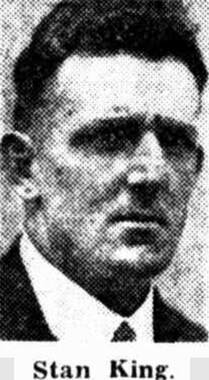
Builder unknown.
Known measurements: beam 5’6”, depth 23”, length 9’11 1/2”.
Bumpkin 13’6”, hoist 12’6”, gaff 12’6”, spinnaker 24’ on foot.
Sail insignia: Gold star on a black square.
Wallaby was launched on Sunday 3 December 1933 for owner Stan King who had been sailing his Kangaroo up to that date and had won the Championship of the Balmain Dinghy Sailing Club a few weeks before. King announced Kangaroo would be withdrawn from racing but he sold it at some stage as it reappears racing a couple of seasons later.
Stan was also frd hand on the 18-footer Avalon which he co-owned with his brother Gordon who steered. Avalon changed insignia to be the same as Wallaby in 1935. The Balmain 10’s raced on Sundays and the 18’s on Saturdays.
Wallaby was not as successful a boat as Kangaroo, but Stan stuck with it, being handicapped around mid-field by the end of the first season, and moving between 3 and 6 minutes in the second season, 1934-35. They managed a 3rd in the State Championship in February 1936 however, but drifted out to 8 1/2 minutes late that season.
But by the 1937-38 season King and Wallaby had hit their stride, winning 6 races in the first part of the season. However on 5 December they collided with the League 18-footer Collaroy and Stan sustained a serious head injury which forced him off the water for the rest of the season. Champion lady skipper Kath Farr steered in one of the later races that season, probably the first female skipper of a 10-footer since Irene Pritchard at the turn of the century. For his time Stan King appeared to have a relaxed attitude to women sailors. King married reasonably late in life in 1939, to a Miss C.Garstang who was a sailor in her own right and who made history by being the first woman to take an 18-footer mainsheet in a number of races in the early 1940's.
Stan resumed sailing Wallaby at the beginning of the 1938-39 season but last season’s success eluded him, other than being first home of only 2 boats to finish on 18 December in a gale. Newspaper mentions of Balmain DSC races become scarce after this date, and though occasional mentions of Wallaby are seen for three more seasons there appears to be no mention of skippers. The 10-footers continued until 14 December 1941 after which they ceased racing for good once the Harbour was shut down because of the War.
Known measurements: beam 5’6”, depth 23”, length 9’11 1/2”.
Bumpkin 13’6”, hoist 12’6”, gaff 12’6”, spinnaker 24’ on foot.
Sail insignia: Gold star on a black square.
Wallaby was launched on Sunday 3 December 1933 for owner Stan King who had been sailing his Kangaroo up to that date and had won the Championship of the Balmain Dinghy Sailing Club a few weeks before. King announced Kangaroo would be withdrawn from racing but he sold it at some stage as it reappears racing a couple of seasons later.
Stan was also frd hand on the 18-footer Avalon which he co-owned with his brother Gordon who steered. Avalon changed insignia to be the same as Wallaby in 1935. The Balmain 10’s raced on Sundays and the 18’s on Saturdays.
Wallaby was not as successful a boat as Kangaroo, but Stan stuck with it, being handicapped around mid-field by the end of the first season, and moving between 3 and 6 minutes in the second season, 1934-35. They managed a 3rd in the State Championship in February 1936 however, but drifted out to 8 1/2 minutes late that season.
But by the 1937-38 season King and Wallaby had hit their stride, winning 6 races in the first part of the season. However on 5 December they collided with the League 18-footer Collaroy and Stan sustained a serious head injury which forced him off the water for the rest of the season. Champion lady skipper Kath Farr steered in one of the later races that season, probably the first female skipper of a 10-footer since Irene Pritchard at the turn of the century. For his time Stan King appeared to have a relaxed attitude to women sailors. King married reasonably late in life in 1939, to a Miss C.Garstang who was a sailor in her own right and who made history by being the first woman to take an 18-footer mainsheet in a number of races in the early 1940's.
Stan resumed sailing Wallaby at the beginning of the 1938-39 season but last season’s success eluded him, other than being first home of only 2 boats to finish on 18 December in a gale. Newspaper mentions of Balmain DSC races become scarce after this date, and though occasional mentions of Wallaby are seen for three more seasons there appears to be no mention of skippers. The 10-footers continued until 14 December 1941 after which they ceased racing for good once the Harbour was shut down because of the War.
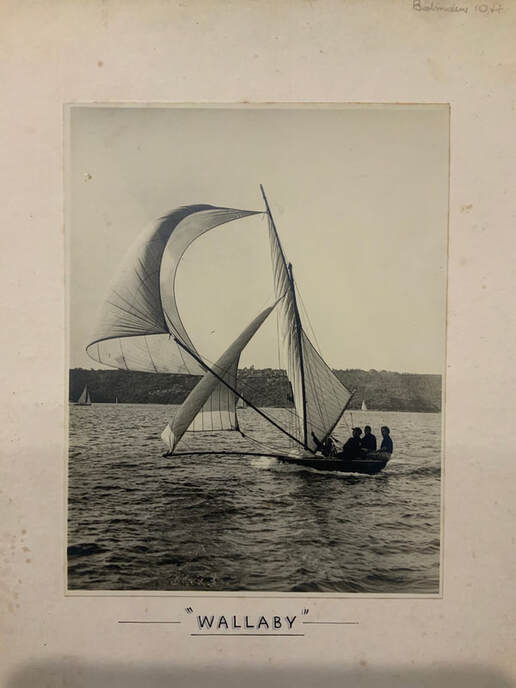
Both photos are from the Frank Burrows family collection. Frank was an early member of the AHSSA and may have been in the crew of Wallaby and Avalon.
Waratah 1907
Builder: Edgar Dearing for Tom Keddie
Insignia: Red and blue crescent with white diamond and Waratah (flower) in square.
Commissioned by Tom Keddie, Waratah was a competitive boat that raced with great success under Tom Keddie who died at the age of 26 in 1909. His brother Wal Keddie who later went into 18-footers sold his own 10-footer and took over Waratah. She appeared in at least three Australian Championships, in 1909 (in which they were 2nd), in 1912 in Sydney (which they won), and in 1922 in Perth. Unfortunately she was one of 7 ten-footers burnt in Perth in the fire that also destroyed local 18-footer Mele Bilo (I) in 1922. There's more on Waratah's story in the YARN on The Tom Keddie Memorial Shield.
Insignia: Red and blue crescent with white diamond and Waratah (flower) in square.
Commissioned by Tom Keddie, Waratah was a competitive boat that raced with great success under Tom Keddie who died at the age of 26 in 1909. His brother Wal Keddie who later went into 18-footers sold his own 10-footer and took over Waratah. She appeared in at least three Australian Championships, in 1909 (in which they were 2nd), in 1912 in Sydney (which they won), and in 1922 in Perth. Unfortunately she was one of 7 ten-footers burnt in Perth in the fire that also destroyed local 18-footer Mele Bilo (I) in 1922. There's more on Waratah's story in the YARN on The Tom Keddie Memorial Shield.
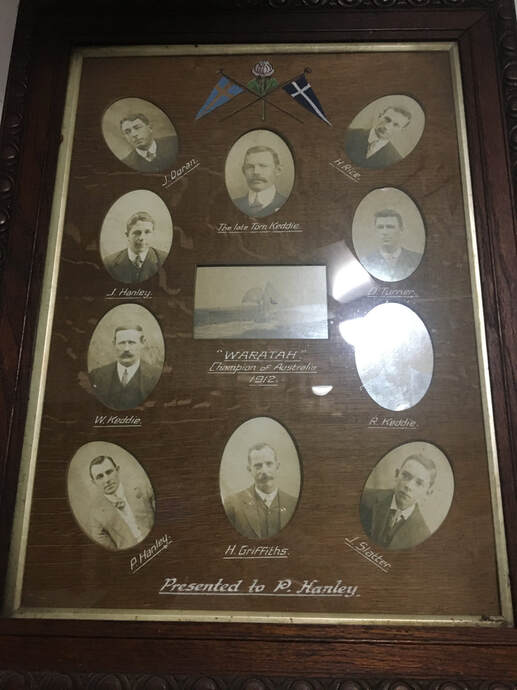
In 2023 Peter Hanley called in to the Sydney Flying Squadron with this framed presentation which had been presented to his Grandfather, enquiring about the boat pictured. I was able to tell him that it is the 10-footer Waratah. His Grandfather, also P Hanley is pictured bottom left. It's great to have items like this which depict the crew, whose names are not often recorded elsewhere. Peter was pleased to find out it was such a famous boat, and noted in observing the Club's Honour boards that several of the crew went on to have significant roles in the Sydney Flying Squadron. The framed pictures commemorate Waratah's win in the Australian Championship of 1912. Not all crew pictured could have sailed on the boat at the same time, the usual crew complement was five. The late Tom Keddie is included because it was originally his boat. The pennants belong to the Lane Cove Amateur Sailing Club (Blue and gold) and the Sydney Dinghy Club (Navy blue and white), the two Clubs that ran 10-footer races in this period before the dominance of the Balmain Dinghy Club.
